Chapter 4
EARTH MAGICK AND MEDICINE OF SPRING
Rebirth & Awaken: Ecstasy & Desire | East · Air · The Maiden

The Portal of the East at a Glance
ELEMENT Air
TIME OF DAY Dawn/early morning | 4am–10am
MOON PHASE Waxing
SEASON OF SOLAR YEAR Spring | March, April, May
EARTH HOLY DAYS Ostara (Spring Equinox) | March 19–22; Beltane | May 1
WHEEL OF LIFE ARCHETYPE Maiden | Age 0–21
ENERGIES Waxing, growing, expansive, curious, playful, innocent, delighting, ecstatic, joyful, adventurous, self-oriented, open-minded, mutable, intelligent, fast-moving, transformative, ungrounded, learning, exploring, divination, imagination, visioning
HEALING HERBS
Medicinal weeds and nourishing herbs Nettles, oat straw, dandelion, chickweed, red raspberry leaf, cleavers, burdock, miner’s lettuce, violet
Herbal bitters Dandelion, mugwort, blue vervain
Digestive system tonics Lemon Balm; Turmeric; Marshmallow; carminative herbs such as mint, fennel, thyme, oregano, and ginger; and other aromatic and pungent herbs. The nourishing herbs and adaptogens tonify the digestive system as well.
Sacred smokes Mullein, damiana, blue lotus, skullcap, passion vine
Nervines and air balancing plants Lavender, chamomile, motherwort, lemon balm, tulsi, passion vine, skullcap
TENDING THE GARDEN Observing and listening; planning and visioning; planting cover crops; feeding soil with compost; mulching; planting new seeds; planting starts, perennials, fruit trees, and flowers; putting in a medicine garden; planting greens and veggies; harvesting flowers; making flower essences; beekeeping; pruning fruit trees
APOTHECARY Flower essences; wild-harvesting weeds; drying nourishing herbs and spring weeds for tea; making weed vinegars, digestive bitters, blood-building syrups, fresh herbal juices, tinctures, and glycerins; harvesting flowers such as rose and elderflower; harvesting other spring herbs such as yarrow, calendula, and lemon balm
RITUALS Earth Whisper ritual; seeding prayers; rituals with seeds; setting intentions; fertility rituals; pysanky (traditional Eastern European egg painting); rituals of cleansing energy with brooms, eggs, crystals, etc.; purification rituals; herbal bathing; rituals of renewal, (re)birth, and celebration

REBIRTH TO REGENERATE YOURSELF, EXPANSIVE MAIDEN

Spring is the time when all of Nature, ourselves included, is reborn. We reawaken to our purity, our innocence, and the sheer delight of expansive growth so characteristic of children. Tulips, daffodils, and other bulbs that have been dreaming in the darkness of Winter’s soil burst through snow, joyfully greeting the young Spring sun. The garden awakens, and Gaia offers fresh wild weeds that cleanse the liver and blood from the stagnation of Winter, regenerating our cells and spirits.
Now is the time to shed the Winter skins of stagnation, old habits, and stale beliefs. As the young Spring sun begins to grow stronger, we encourage the youthful flame inside us and in nature with practices, foods, and rituals.
The archetype of the Maiden corresponds with the Spring portal. Some of the most ancient rituals and holidays celebrated at this time are designed to feed the fertility of the Maiden and the reborn Earth, which ensures our survival and the abundance of full gardens we will enjoy in the Summer months.
All stages between embryo and fertile Maiden have something to teach us about riding the waves of regeneration and cultivating the growing life force of the Spring months. Thus, we honor and tend to the medicine and magick of the newborn and child archetypes as well. We renew ourselves by connecting to sheer delight, spontaneous play, and childlike joy.
By playing, we learn. By expanding ourselves through adventure like the youth, we grow and come to know ourselves better, widening our perspective and becoming more open, flexible, skilled, and, ultimately, wise. By renewing our innocence, we can avoid carrying old wounds and blockages into the future, and we can experience a Spring revival in our relationships, creativity, and work. By mothering our inner child and giving ourselves opportunities to play, we can mature from a place of fullness and wholeness without becoming resentful when the responsibilities of the Summer portal demand our energy.
As we delight in the renewal within and around us, we greet the first weeds of Spring and the nourishing herbs in the garden and in the wild. Dandelion, chickweed, wild mustard, nettles, and burdock awaken our wild spirits, cleanse stagnation from our blood and organs of elimination, wake up our digestion, help us in rebirth, and are full of nutrients, minerals, vitamins, and enzymes that flood our body with wild nutrition and a surge of green energy.
In your medicine garden, your perennial herbs will begin to sprout new life. You will be excited to start new seeds and feed the awakening vitality of your soil with compost or a cover crop. Fruit trees will blossom, and flowers will sing to your expanding spirit. It is a wonderful time to make flower essences for your apothecary—a form of vibrational medicine that floods the body and spirit with the resonant frequency of a flower’s spirit song.
The East’s Portal of Rebirth opens to you each day at dawn, each waxing moon, each Spring season, and in the youth of your life. Use this time to awaken your childlike joy and a sense of play, and to protect your innocence. Support yourself with gentle, nourishing practices and follow your joy and pleasure—they are sacred. The delight in your heart is like the apple blossom, without which there can be no fruit.
Rebirth to regenerate yourself,
expansive Maiden.
ENTERING THE PORTALS OF THE EAST

The portal of the East is the time of waxing energy present in Nature’s cycles. In the twenty-four-hour cycle of a single day, we enter this portal as the sun prepares to rise and when we wake up each morning.


In the lunar cycle, we connect to this portal with the waxing crescent moon rebirthing herself in the dark night sky. Her growing light inspires us to set new intentions for the “moonth.” By weaving the prayers in our hearts into the heavens, we can experience the mysterious germination of the seeds we have planted as we follow her into fullness in the night sky.
On our Wheel of the Year, the season of Spring spans the months of March, April, and May in the Northern Hemisphere, with the Spring Equinox (March 19 to 22) marking the official start of Spring, the year’s moment of ecstatic rebirth. At Spring Equinox, we once again hang suspended in a sacred moment of balance between light and dark—between the length of day and night, in a midpoint between the Winter and Summer Solstices. From here on, the energy of the sun continues to grow in strength, light, and power until its peak expression on the longest day of the year: the Summer Solstice (June 19 to 23).
Midway between the Spring Equinox and the Summer Solstice, we celebrate the cross holiday of Beltane (May 1), which carries the energy of the mature and fertile Spring. Ancient and modern Earth-worshipping festivals and celebrations feed the fertility inside of us and inside the Earth, as well as our creativity, so we can continue blossoming into a fruitful Summer. It is at Beltane when the Goddess and God within the Great Web of Life consummate their passion and love for each other. The transformative portals of ecstasy, intimacy, union, passion, love, and bliss open as the light of the sun penetrates the moist, fertile, dark Earth.
In the largest wheel we explore together—our lives—the East corresponds to our youth and the archetype of the Maiden. The strong energy of growth and expansion carries us through the immense transformations from embryo to fertile folk—from the seed felt in Imbolc (February) through the rebirth of Spring and the Maiden who seeks expansion and growth (March), to the mature and fertile ones who jump over the ritual fire of passion at Beltane (May), to the peak of energy expressed at the Summer Solstice’s Mother archetype.
This is the time to expand our energy and cultivate our rebirth and growth, planting seeds and intentions and mothering ourselves lovingly into sovereign, joyful, powerful, growing beings of light and love!
“Energy is eternal delight.”
—William Blake
ENTERING THE EAST EACH MORNING

In the wheel of the day, East corresponds to dawn and early morning, from 4:00 to 10:00 a.m. Many ancient spiritual practices encourage us to wake up before dawn to greet the rising sun. If you feel so moved, try for a few minutes of quiet solitude immediately upon waking, before starting your day. It makes a tremendous difference in the management of stress and the health of the spirit to start your day connecting to your first breaths and moments of awareness.
As you birth your rituals for entering the portal of East, allow it to feel gentle, as if you were midwifing your own birth. Create a soft and nourishing environment in which you can transition from rest to renewal. Connect to the energy of the newborn as you call in simple, gentle rituals that bring clarity and connect you to the purity of your heart for the remainder of the day. For instance, you may light a candle upon waking.
Once you have spent some time in simple, silent wonder, allow the energy of gentle love and connection to ripple out from your heart to your body and take form in a nourishing morning practice. This is wonderful time for a few simple self-care rituals that otherwise are hard to fit into the day. Once everyone is awake and the day picks up its energy, we are on a ride until we begin intentionally unwinding at dusk. By then, we are often tired, and a set of different opportunities for nourishment present themselves.
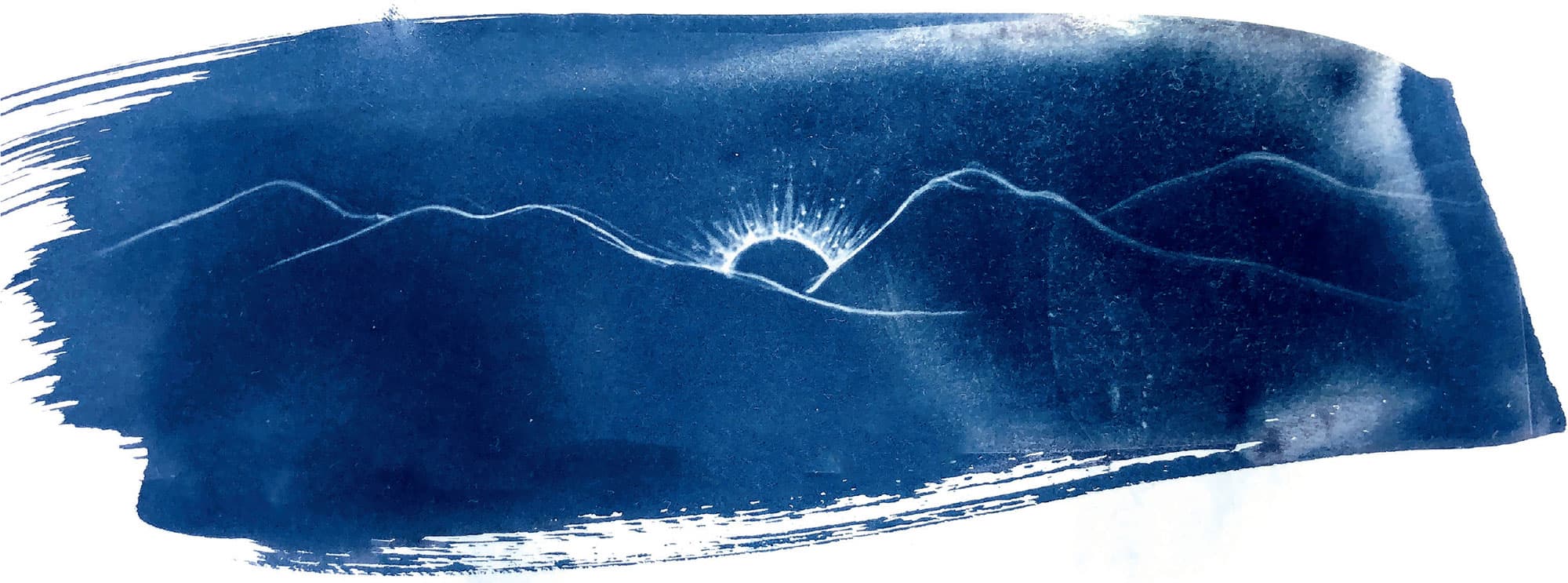

Morning Practices to Weave You into the East
These morning practices are ideal for the Spring portion of the day as well as the Spring times of your menstrual cycle, the lunar cycle, the year, your life, and your children.
• Connect to the feeling of being reborn in the first moments of waking. Let it be very, very simple and sweet.
• Use a gentle alarm sound, such as a birdsong. Compost the habit of reaching for your phone first thing—instead, give your hands a new practice of reaching for your body while still lying in bed. Rest your hands on your belly, heart, or womb and close your eyes, connecting to your first breaths of awareness.
As you breathe, connect to the awareness that you have a living, warm body. I then float in that space between dreaming and wakefulness and recall my dreams. My hands on my belly relax my nervous system so I do not jump into a feeling of rush, but rather enter the day with a calm, slow, sweet, loving energy. I say hello to my body and spirit and give gratitude. In colder months I sometimes stay in bed in this position for my morning meditation; in warmer months I transition to meditate outside in the dawn air.
• Simple self-care morning practices may include tongue scraping, which removes bacteria accumulated overnight.
• Dry brushing your body to awaken your circulation and move lymph.
• Oil pulling, which is wonderful for dental hygiene and is detoxifying to the body.
• Warm abhyanga massage nourishes and calms the nerves for the remainder of the day.
• Drinking warm lemon water or a shot of apple cider vinegar and water upon rising flushes out toxins and awakens the digestive system.
• Drinking an overnight infusion of a nourishing herb on an empty stomach before breakfast.
• Meditation and yoga.
• Greeting the sun with gentle movement, stretching, or song.
• Intuitive dance or a morning dance party.
• Going for a hike or run to energize and activate the body and mind and release stagnant physical and emotional energy.
EVERYTHING YOU NEED TO KNOW ABOUT NOURISHING HERBS

If you incorporate only one practice into your daily life, I offer you the gem of gems: drinking a nourishing wild-weed infusion daily. Nourishing herbs are mostly wild, abundant, nutrient-rich weeds such as nettles, oat straw, dandelion, chickweed, burdock, red clover, cleavers, and red raspberry leaf. Flooding your body with the vitamins, minerals, and enzymes contained in the vitality of weeds that grow in intact, wild ecosystems is life changing. It is the first and primary practice we teach at the Gaia School of Healing and Earth Education, and each year we see students transformed from the inside out thanks to the nourishing herbs.

Nourishing herbs cleanse, renew, and replenish us with wild vitality as they weave us into ancient Earth intelligence and wild remembering. The weeds nourish our cells and our souls. When we begin to drink them, we often find our bodies gulping them down, quenching a thirst we never knew we had, much less knew how to satisfy. Because they come from wild ecosystems, the soil they grow in is full of biological and spiritual information you will not find in cultivated, tilled land.
Spiritually, nourishing herbs replenish us in a way that makes us feel deeply and intimately connected with the Earth Mother. When I drink an overnight infusion of nourishing herbs, all the cells in my body and my soul rejoice, feeling home and whole.
Physically, nourishing herbs are some of the highest sources of vitamins, minerals, and enzymes. They are healing to the gut and digestive system, are alkalizing, and help our body assimilate more nutrients from food. They support a healthy circulatory system, build blood, and often tonify the heart. They are gently cleansing to the organs and systems of elimination, helping our body detoxify in a healthy, slow, and deep way. They help our body build new tissue and create new healthy cells, and as such they are great allies for pregnant women creating new life and creating more nutrient-rich breast milk. They support the endocrine system, balancing hormones in all stages of our lives, for all genders. Certain herbs are best for specific phases or hormones. They tonify the nervous system, helping us become more resilient to stress, more adaptable, clear minded, balanced emotionally, and heart centered.
Emotionally, nourishing herbs are grounding. Our bodies relax when they are no longer desperate for nutrients and love, and our emotions consequently become more harmonious. As we drink the nourishing herbs, we take in the spirit of wild places and the body of the Earth. We become more resilient to stress and more compassionate toward ourselves and others.
How to Make an Overnight Infusion
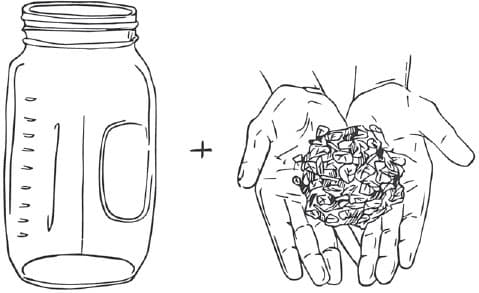
1. Put one handful of herbs into a glass jar.
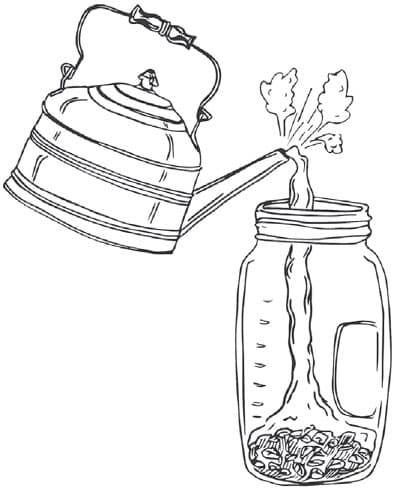
2. Pour hot water into the jar.
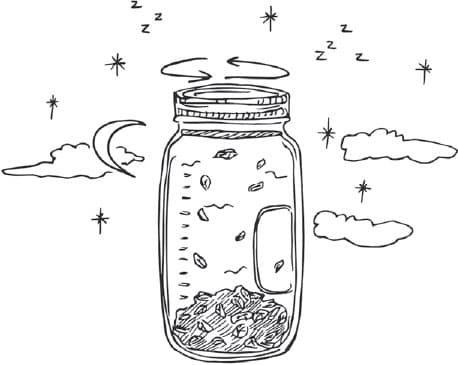
3. Close the lid tightly and let the mixture infuse overnight.
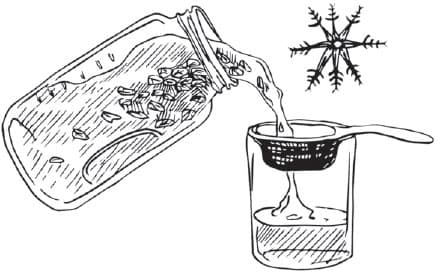
4. Strain. Refrigerate or carry with you.
Drinking these herbs feels like drinking from the teat of the Earth Mother herself. Our bodies relax and energize, and our hearts and minds open. Oh, the miracles that happen when we move through life feeling nourished! We become more joyful, energetic, and inspired. The throb of wildness that the spirits of these plants carry awakens the wild remembering inside of us, giving us fresh vitality and vigor. Drinking wild-weed infusions is the most effective way I know to weave ourselves back into the fabric of the Earth and the Great Web of Life.
Your new ritual is to make an overnight infusion before going to bed each night. Allow it to be your practice. Each night after tidying up the kitchen after dinner, infuse your herbs and leave them out on the kitchen counter so you may effortlessly receive them upon rising in the morning.
Although all nourishing herbs have some healing characteristics in common, each plant also has its own personality and special gifts. The plant profiles that follow will educate you more on each herb. I recommend choosing one and working with it daily for a month, noticing the layers of healing, insights, transformation, and gifts received. After a month you will have developed a strong personal connection to and knowing of this plant, and you may continue working with it daily or switch to another. Mixing nourishing herbs and creating herbal blends works better once you know each one well in your own body. Otherwise, if consuming many herbs at once, you may be unsure which plant is doing what. In our tradition of herbalism, we like to work with “simples”—one herb at a time—so we develop an acute knowing of how this plant’s healing manifests. This makes you a better herbalist and, ultimately, will help you formulate better blends.
SPRING NOURISHMENT AND CLEANSING

Our morning practices cleanse us of night stagnation, waking up our bodies with loving intention, breath, and movement. They cleanse toxins and awaken the flame of the digestive system. In the Spring and in the morning, we are given opportunities to cleanse and become light, bright, and energized.
The meal associated with the portal of the East is breakfast—the breaking of the night’s fast, thus ending the Winter portion of the wheel of the day. Begin your day with your nourishing herb infusion, drinking as much of it as your body desires. When your body tells you it is hungry, eat breakfast. However, nourishing herbs are so full of nutrition that they often delay hunger. If you are thin, make sure you are nourishing yourself with food. If you are over your natural weight, notice the feeling of becoming full, simply by drinking the herb infusions. As you continue to drink daily infusions of these nourishing herbs, cravings for junk food and stimulants will likely begin to disappear, and you may find that your portion sizes naturally shrink.
Spring can be an ideal time to lose some extra weight that our bodies naturally acquire to stay warm in the stiller months of Winter. I allow my body to wax and wane with the cycles of nature. My body weight fluctuates by a couple of pounds during the moon and my menstrual cycle, and I gain a few extra pounds each Winter. The Wise Woman tradition takes the approach of nourishment and self-love, and we cleanse stagnation without the rigid, harsh, and often punitive approach of “detoxifying.” I find the popular detox diets and cleanses to be hard on the physical, emotional, and spiritual body. The strict rules override our intuition. The nervous system often becomes more anxious as it tries to understand the stress the body is experiencing. Many strict cleanses and diets put the body into “starvation mode” and can feel like punishment.
More importantly, these practices do not cultivate a relationship of trust, deep listening, and caring between the body and soul. In a world of “shoulds” and constantly changing templates for the perfect body, look instead to lifelong cultivation of deep listening to natural cues. Listening to your body will heighten its intelligence and ability to communicate what it needs—after all, our bodies are naturally made to detoxify. By taking the Wise Woman approach to health, we can lovingly guide the soul into “blissipline” (bliss + discipline) instead of punishment and control. We can allow our bodies to show us what their expression of health looks like, in different moments during our life journey.

That said, Spring is a wonderful time to gently cleanse our body from the inside out. We can easily enhance our body’s natural self-cleansing ability, lightening and energizing the body with herbs and supportive practices.

Cleansing in the Spring: A Nourishing Approach to Losing Winter Weight
Spring is a time to embrace practices and foods that feed our health and renew our bodies after Winter. If that means a little Spring weight loss for you, here are some tips, from most gentle to most actively cleansing.

• Commit to eating what your body is craving when you are hungry, eating slowly and mindfully, enjoying it, and stopping when you are full. Women, Food and God by Geneen Roth is an incredible book that teaches us how to transform our relationship with emotional eating through deep spiritual insights.
• The morning body-cleansing practices of tongue scraping, dry body brushing, and oil pulling enhance detoxification, cleansing, and weight loss.
• Drink an herbal bitter twenty minutes before a meal to stimulate the production of digestive enzymes, which help your body break down food. (See here for a recipe.)
• Have fun cooking! Make food with a friend or loved one. Make a meal special and then take your time enjoying it.
• Practice slow, mindful eating. Chew your food to help your body absorb nutrients, to aid in digestion, and to improve energy.
• Practice deep belly breathing before you eat to activate the parasympathetic nervous system and calm the body. If we eat when stressed, we tend to hold weight. Using breath or a nervine tea to get calm before eating makes a huge difference in helping us effortlessly reach our natural weight.
• Drink herbs such as schisandra and gynostemma throughout the day to increase energy while curbing appetite, getting you out of the afternoon slump that can lead to reaching for sweet snacks. Nourishing herbs also decrease appetite. Drink plenty of herbal teas and lemon water throughout the day.
• Drinking yerba mate in the morning delays hunger, increases energy, and stimulates the digestive system. The caffeine in mate and coffee helps with intermittent fasting, though it is taxing on the adrenals. If you are not addicted to caffeine, I recommend you enjoy and preserve your lack of addiction!
• Intermittent fasting is an effective way to lose weight for many people. It prolongs the period at night when we do not take in calories to anywhere from thirteen to sixteen hours; for example, 7:00 p.m. to 11:00 a.m. This changes hormones and helps you burn excess fat. However, it is not effective if you feel starved and then binge eat or eat significantly larger meals. You may drink nourishing herbs, teas, mate, coffee, and so on during your morning fasting to help curb hunger and to keep the body feeling supported and calm. Do your research; this pattern of eating has gained popularity, but it is not for everyone.
• Alternatively, you can try not to eat after a certain time at night, such as 6:00 or 7:00 p.m., without placing a time restriction on the morning meal.
SPRING CLEANING

Spring is a time of clearing, cleansing, and making way for the new. Just as we clean our body from the inside out in the morning and in the Spring, we ripple that energy out into the body of our home and lives. A “Spring cleaning” is a powerful spiritual and energetic practice in addition to being practical and physically refreshing.
By digging deep into places in our home where there has been stagnation—boxes, piles of clothes, under the bed, in corners and cabinets—we move dense, stagnated energy and allow it to leave our physical space. As we release the old, we allow for new energy to replace it. We shake out our old identities and create space for transformation, for reinventing ourselves, for inviting in something new.
Feng shui is a Chinese practice developed thousands of years ago to create harmony and health in our environment and lives, using the laws of nature to cultivate more chi, or energy. According to this philosophy, energy must flow in our home, and that means having order and space, even in the hidden places such as in cupboards and under beds.
Go through your possessions. Release anything you do not use and that does not bring you joy. These items are, perhaps subconsciously, weighing you down. Remarkable and surprising spiritual and emotional transformations occur when we radically release possessions. Travel life lighter, with space to be more open.
A Witch will perform the act of Spring cleaning like a ritual, creating sacred space and allowing the physical enactments to connect to deeper intentions. When clearing your home, weave in the magic of the four elements. Use your prayers and intentions to release the old and make room for miracles to blossom in your Self, home, and life.

Air
Swing open the windows and the doors, inviting in Spring winds and cool breezes to cleanse your home. Let light pour in. Play music, and let it sing out of the home into the outdoors.
Fire
As you go into deep and dark places to clean your home, burn blessing herbs of local cleansing plants from your garden or ecosystem, such as juniper, sage, mugwort, or cedar or pine resin. These plants have been used for centuries for their physical, energetic, and spiritually cleansing powers. They banish heavy, negative energy from the auric field, and their smoke has antimicrobial and antibacterial properties.
Sometimes, when clearing out an old closet, you may feel flooded by old memories, energies, and a time that no longer exists. Burning sage or another blessing herb helps dispel the energy, allowing it to go back to Source, supporting renewal.
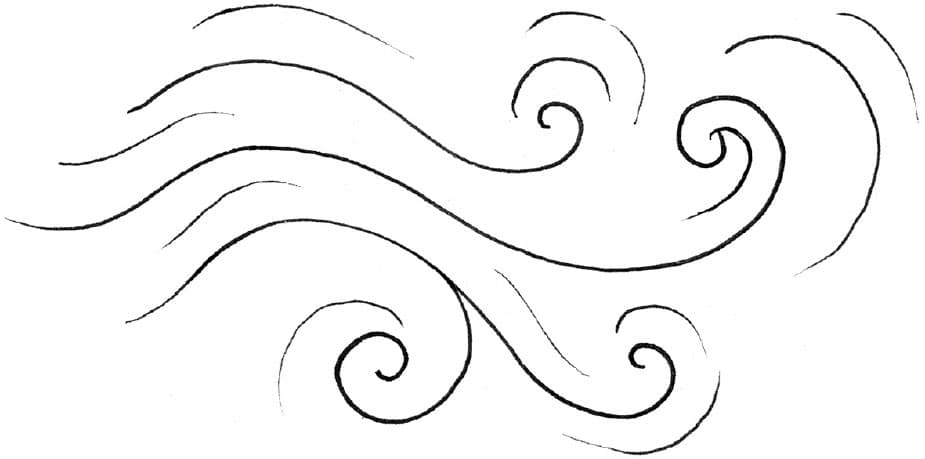
Less commonplace blessing herbs, such as copal, palo santo, and frankincense should be used sparingly, because they are overharvested. I call the resins “tears” to help us remember how precious each drop of tree sap is. Perhaps you will burn a couple of tears of frankincense upon completion of your home cleaning. It has such a high vibration that it can make a space feel like it is vibrating at a sacred, angelic note of light and clarity.
Water
Once the air is fresh and purified and the home is breathing and cleared out, it is time to sweep and wash the surfaces in your home. The Witch’s classic magickal tool, the broom, comes in handy for this task. Try sweeping in a counterclockwise direction, calling out all that you are releasing from your home. End by reversing your course; sweep clockwise as you call in new energies and intentions. Wash and purify all the surfaces of your home—the furniture, the walls, and the floor. Standard commercial cleaning products are incredibly toxic and full of by-products from the petroleum industry. Instead, choose a biodegradable product that is safe for animals and children. Or go simple, pure, and cheap by cleaning with white vinegar, baking soda, and liquid castile soap! (See here for an herbal-infused white vinegar for Spring cleaning.)
Earth
Water and feed your plants both inside and outside the home with compost tea, a rich liquid full of microorganisms made from brewing compost. Your resident plants will lift their vibrations and exude aliveness and Spring vitality all around. Sweep the front stoop or porch and tidy up the path leading home. Leave shoes outside the door, as many traditional cultures have always done. Studies show that outdoor shoes worn in the house are a larger source of children’s pesticide exposure than eating nonorganic fruits and vegetables.
Finally, bring some of the outdoors into your home. Maybe a branch that needed to be pruned can be brought indoors to blossom and bring in the energy of Spring? Maybe a beautiful river stone or feather you found on a walk would like to come home and be placed on your altar? Fill your home with flowers, sit back, drink some tea, and enjoy the sacred space that is your sanctuary!
May your home be blessed.
May you welcome in the spirits of Nature and find nourishment in your sacred nest.
And now fly, Maiden free, to discover the miracles of all you can be!
SETTING INTENTIONS, BIRTHING NEW LIFE, AND RENEWING OURSELVES

Reborn from the darkness of the new moon, we enter the Spring of all cycles cleansed and open, with visions and hopes for the future. We set new-moon intentions and watch them grow as the moon waxes to full. We cultivate nourishing practices and encouragement to help our metaphorical seeds germinate, connecting to wonder, joy, and delight—energies embodied by children. It is time to be light, carefree, and expansive. Like young people who seek new experiences in order to grow and transform themselves, we too may feel more social, energized, and adventurous following the dark moon.
A woman’s time of bleeding is her dark moon and her Winter, and her Spring is the follicular phase of the cycle, which typically lasts until the thirteenth day. It is a time to rebuild blood with herbs such as nettles and angelica. Estrogen increases, the uterine lining thickens, and as Spring matures into Summer, testosterone and libido increase right before ovulation. In order to ride the regenerative currents of menses, one commits to truly resting in their Winter (bleeding) time. Now, in her spring, she feels reborn, energized, motivated, optimistic, and enthusiastic. This is a great time to begin new projects, to follow your own bliss, to take some creative risks, to reach out to others, and to plan the cycle ahead, along with any new intentions or actions you wish to implement. The boldness and optimism of the maiden are best cultivated by having plenty of time to come from the Self. For your own health and vitality and the energy of your creative endeavors, do not shortcut this phase and jump straight into the Summer time of service, taking care of others, and continual action. Stay connected to the delight that will blossom into ripe fruit.

THE MAIDEN ARCHETYPE

The gateway of the East is connected to the Maiden archetype. Here, we connect to the energy of youth that is growing, expanding, and looking for new experiences. We go from the innocence of a child and the need to receive nourishment to the bursting idealism of young adults who seek adventure and experiences that will help them grow and develop. This is a time to broaden our horizons, to learn new things and expand our minds, and to open ourselves to limitless possibilities. This is an important archetype to embody in the creative cycle, and in all journeys on the Great Wheel of Life. There will be a time to refine and focus, but that is not the energy of the East. We must begin by opening ourselves to possibilities we may have not considered, in order to be filled with fresh creative energy, which allows us to birth prolifically time and time again.
The morning practices in this chapter connect you to the embodiment of being reborn anew each morning. Self-care is a priority of the Maiden archetype. Practice to cultivate vigor and optimism as you dream into the possibilities and intentions of your day. The practices of the menstrual cycle, as well as the new moon cycle, encourage us to be a little more “self-centered” than usual in the time that corresponds to the Maiden archetype. For youth to grow into vibrant and powerful adults, it is important for them to follow the beat of their own drum, to follow and discover their bliss. Renew your creative projects and your commitments and responsibilities by connecting to the Maiden archetype in this way as you set new intentions each moon cycle.
And when it is Spring, play! Plan adventures, go outside, move your body in nature, and explore the sun and the breeze as Beloved. Open your senses to the natural world and receive pleasure from connecting to Nature. Lie in a meadow and sing to the sun on your skin. Be wild and free! The joy and delight will bubble into a life-giving spring that will feed you and your loved ones when the time is ripe in the Summer cycles to come.

“If a child has been able in his play to give up his whole loving being to the world around him, he will be able, in the serious tasks of later life, to devote himself with confidence and power to the service of the world.”
—Rudolf Steiner
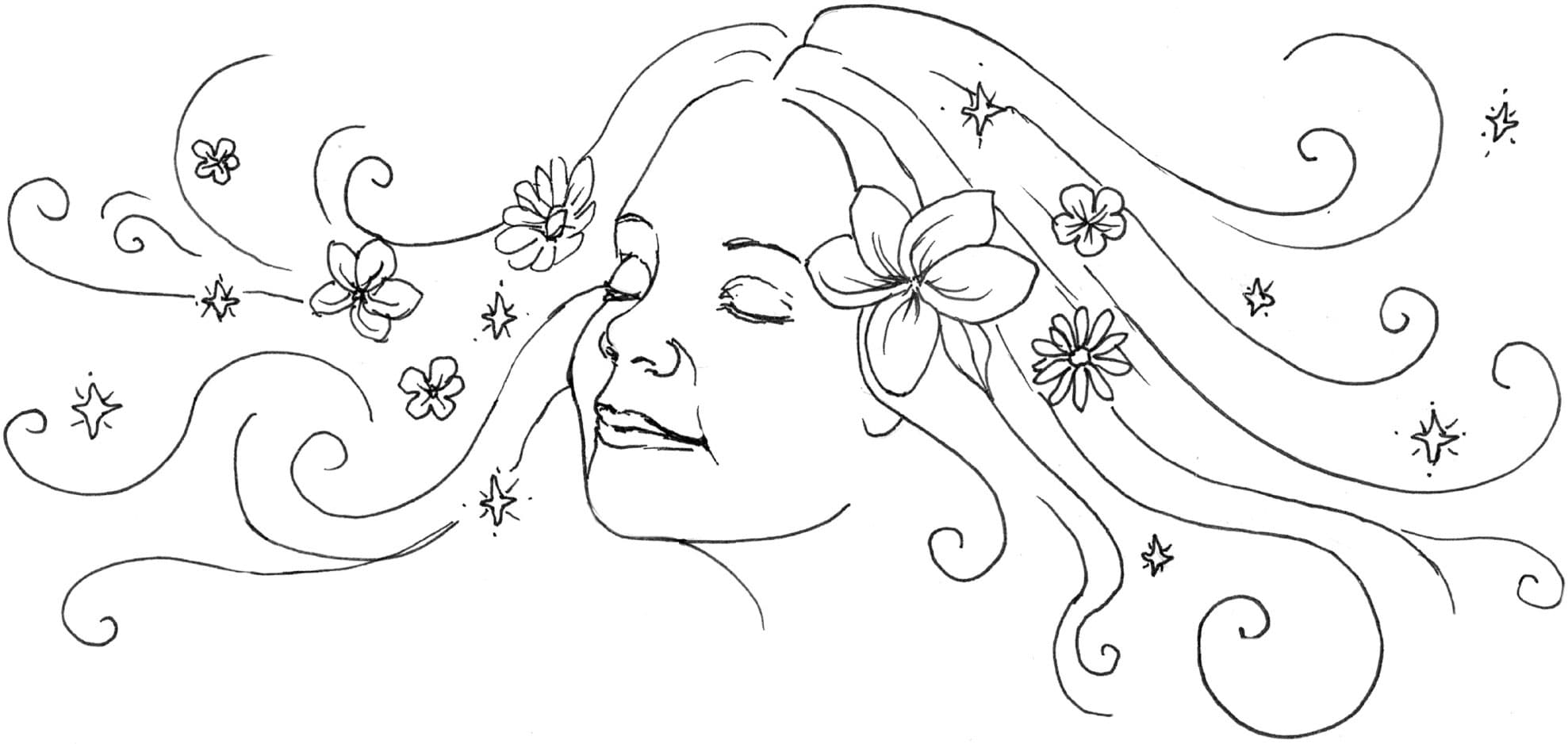
EARTH MEDICINE OF THE EAST: WILD WEEDS

When Gaia’s Earth body awakens after the slumber of Winter, she generously offers us medicine and food that is ideally curated for this time in our journey. What are the first plants to pop up in your ecosystem after Winter? Most often they are nourishing weeds—dandelion leaves, chickweed, nettles, raspberry leaves, plantain, miners lettuce, oat straw, and mustard greens.
What do these nutritive plants have in common? They are given to us in absolute abundance by the Earth herself. In the East, we can be like children, receiving the deep nourishment from the Earth Mother, who showers us with prolific edible weeds as if she were encouraging a baby to drink from the breast. This is the time for us to relax into receiving, to flood ourselves with nourishment, so we can be filled with vitality and growth.
The medicinal weeds that are so prolific in the Spring are superfoods. They are high in minerals and vitamins, and they help build our blood. In this way, we see how the plants of Spring are optimal for the corresponding phase of the moon. The blood that was lost during the menstruating time of the dark moon is replenished with our plant allies of the East. Nourishing herbs, the abundant wild nutrition of the Earth Mother, are the foundation of our tradition of folk medicine. Rather than working with rare, expensive plants with ethically questionable environmental sourcing, the Wise Woman tradition works with the plants that are wild, abundant, local, and free. (See more about nourishing herbs shown here.)
Some wild weeds are bitter in flavor. Herbal bitters are wonderful allies for the Spring as well; the taste of bitter stimulates the production of bile in the stomach, aiding us in digestion. When we come into the Spring after a long Winter, we may have excess physical weight or feelings of heaviness, sluggishness, and stagnation. Lucky for us, Mother Nature generously offers us an abundance of food that wakes up our digestion, helps our body naturally cleanse and detoxify, and brings in green vital energy so we too can awaken with all of Gaia in the Spring, during the waxing moon, and each morning. This inner Spring cleaning often feels intuitively right after Winter. Many people will add more fruits and vegetables to release the old and nourish the newness of life. Similarly, starting the day with a nourishing tea will also awaken digestion and nourish our reborn bodies, minds, and spirits.
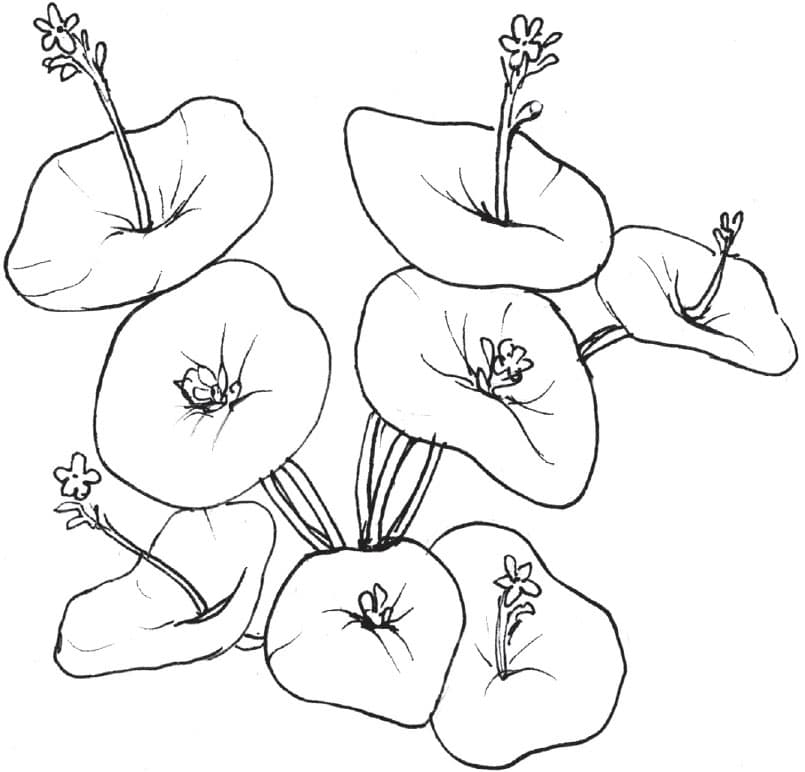
SPRING RECIPES and MEDICINE MAKING

Nourishing Herb Tea
Start your day with an overnight infusion of a nourishing herb. This one practice alone will completely transform you. If you have not made an infusion (an extraction of four or more hours), you can still make tea, which is a hot-water extraction of twenty minutes or more. By using more plant material, you can get a strong, deeply nutritive warm beverage. Here is the base method for making it, followed by a couple of my favorite tea blends. Use a quantity of herbs that is roughly what will fit in the palm of your hand. (The folk method is to measure using your own body.)
Yield: approximately 1 quart (946 ml)
7 tablespoons (38.9 g) or a handful dried nettles, red clover, oat straw, or a combination
1. Place the dried herbs into a quart jar.
2. Pour boiling water over the herbs and immediately cover the jar with a lid so the medicinal steam does not evaporate. Allow it to infuse as long as possible, or for a minimum of 20 minutes.
• • • • • • • •
For nourishing medicinal roots such as burdock or dandelion, extracting the medicine in simmering water leads to a stronger and quicker end product than simply steeping overnight in water from the kettle.
Yield: 11/2 quarts (1.4 L)
7 tablespoons (49 g) dried nourishing herb root such as dandelion root, burdock root, or eleuthero root
1. Bring the herbs to a boil in 11/2 quarts (1.4 L) of water in a small pot, covered, over high heat.
2. Lower the heat and let simmer for 10 minutes.
3. Strain and serve. You can likely reuse the roots again for another extraction.
Nourished and Chill Tea
This crowd-pleasing tea can be served hot or over ice, with or without honey. It’s the perfect blend for introducing healing herbs in a delicious and delightful way. It offers the minerals, vitamins, enzymes, and cell-renewal properties of the wild weeds without the earthy taste that we wild Green Witches love and recognize as the delicious taste of the Earth Mother herself—but which can be an acquired taste. The peppermint leaf brightens the blend and gives it a refreshing flavor, making it easy for all to drink, especially children. Adding a spoon of honey makes it absolutely delightful and a favorite for all.
This blend is reviving and renewing while gently cleansing stagnation from the body. It can be an ally for anemics, those who wish to rebuild their blood during or after their moon cycle, and pregnant people who may need assistance with nausea in their first trimester. This blend is grounding to the nervous system and opening to the heart, breath, and mind—it’s balancing to the air element. Taken as a daily blend, it may help those who wish to heal their adrenals, to strengthen their nervous system, cardiovascular system, reproductive system, or digestive system, and to balance their mind. As with all nourishing and adaptogenic herbs, the cumulative effect is profound, so I recommend working with this blend every day for a month, a full lunar cycle, or longer.
Yield: approximately 1 quart (946 ml)
2 (11 g) tablespoons dried nettles
2 tablespoons (11 g) dried oat straw
2 tablespoons (3 g) dried peppermint
1. Place all ingredients—or a handful of the blend—in a quart-sized mason jar. Top off with hot water, place the lid on it right away, and let it infuse.
2. Drink after at least 20 minutes as a hot tea, or continue to infuse overnight and drink daily upon rising.
Sweet, Spicy, Alive, and Awake Tea
Working daily with the nourishing herbs to flood the body with nutrients while strengthening the systems of elimination can feel like a grounding, warming, delicious hug, especially when working with the roots of wild weeds and adaptogenic herbs. Nourishing our root chakras is part of our primary practices as Green Witches, and this tea blend builds upon the work of the Winter portal and the grounding and warming “Sweetly Rooted I Rise Tea” found in that chapter (shown here).
Now that Spring is here, we seek to support our activation while continuing to deeply nourish our nervous system so we do not go into a chaotic air element. It’s an easy pitfall that feels like a burnout or overwhelm in the excitement of Spring and often corresponds with a body shutdown involving allergies, tiredness, or a cold.
Working with this blend daily could help strengthen your nervous system, immune system, circulatory system, digestive system, and endocrine system and build your deep reserves of energy, while drawing on the stimulating and energizing effects of the adaptogenic herbs.
If you find yourself reaching for stimulants such as sweets and coffee, opt for this blend first. Feel free to add coconut cream and a low-glycemic sweetener for a delicious, energizing, chai-like caffeine-free tonic that gives the comfort, warmth, and energy we seek from coffee.
I keep a pot of this tea on my stove and enjoy it often on chilly days and after a meal as a digestive and to satisfy a sweet craving. With carminative herbs such as fennel and cinnamon, it assists with bloating and digestion as well as circulation, keeping us warm and supporting the heart.
Yield: approximately 1 cup (105 g)
2 tablespoons (14 g) eleuthero root
1 tablespoon (7 g) burdock root
1 tablespoon (7 g) dandelion root
2 tablespoons (14 g) astragalus root
2 tablespoons (14 g) rhodiola root
2 tablespoons (14 g) marshmallow root
3 tablespoons (11.3 g) Ceylon cinnamon chips
2 tablespoons (12 g) fennel seeds
1 slice (1/2 teaspoon worth) turkey tail or reishi mushroom (optional)
1/2 teaspoon (4 g) licorice root
1/2 teaspoon (4 g) ginger root
1. Combine all ingredients and store in an airtight container.
2. Use one handful of the blend per quart (946 ml) of water. Either make a hot overnight infusion or simmer gently, covered, on the stove for at least 30 minutes. Add more water as necessary.
Black Herbal Coffee
For better or worse, I have become a connoisseur of single-origin, fair-trade organic coffee. My love of coffee—and of my adrenals—has made me determined to meet my need for coffee’s comfort and energy in herbal ways that do not push and deplete my nervous system. If you have a need for a boost of energy, consider matcha, cacao, or mate beverages, which have caffeine, or working with rhodiola or schisandra, two stimulating adaptogens.
To satisfy my desire for the delicious flavor of coffee, I used to work with medicinal mushrooms from my native Poland, but some of them are currently overharvested, so I no longer do. I grieve the overharvesting of my beloved mushrooms, which were some of my closest herbal allies; they completely satisfied and healed my coffee addiction. This recipe is a close second for matching the flavors of coffee. It is grounding, nourishing, and supportive to the nervous system and organs of elimination. It is not stimulating and is caffeine free.
Yield: 1/2 gallon (1.9 L)
1 small slice of turkey tail mushroom (about 1 teaspoon worth)
3 tablespoons (21 g) roasted dandelion root
3 tablespoons (21 g) roasted chicory root
2 tablespoons (14 g) burdock root
1 tablespoon (7 g) fo-ti root
2 tablespoons (14 g) eleuthero root
1 tablespoons (7 g) astragalus root
1 tablespoon (7 g) marshmallow root (optional)
2 tablespoons (7.5 g) Ceylon cinnamon chips (optional)
1. Medicinal mushrooms should be decocted (gently simmered with a lid on) in order to get a strong water extraction. A little sliver of dried or fresh medicinal mushroom will go a long way. Begin this blend by decocting the turkey tail with the cinnamon chips, if using them, in 1 gallon (3.8 L) of water for a couple hours.
2. Turn off the heat and let the mixture cool to about room temperature.
3. Bring the mixture back to a gentle simmer for a couple hours once again. Repeat this throughout the day until about half of the water has been reduced.
4. Add the remaining herbs and bring back to a simmer for 1 hour, making a strong black herbal “coffee.” I keep this pot on my stove and heat it up, enjoying many cups of this herbal coffee a day. Pour it into a large jar or container and store overnight in the fridge without straining.
Morning Elixirs
A morning elixir made with adaptogenic herbal powders, healthy fats, and collagen (optional) can replace or accompany breakfast while giving us the protein, fats, and vitamins we need to fuel our bodies and souls. It can be a wonderful midmorning treat that helps us continue rising towards the energetic peak of the day. It can also lift us out of the afternoon slump, satisfying the desire for something sweet, filling, and delicious without bogging down the digestive system or bringing in stimulants such as caffeine or sugar.
How to Build an Epic Elixir
Liquid Base + Herbal Powders + Healthy Fat + Low-Glycemic Sweetener + Fixins = Elixir
Blend all ingredients in a high-speed blender to create a frothy beverage. Sprinkle with optional fixins to serve to yourself or a friend!
LIQUID BASE |
HERBAL AND OTHER POWDERS |
HEALTHY FAT |
LOW-GLYCEMIC SWEETENER (OPTIONAL) |
FIXINS (OPTIONAL) |
1 mug, serving = 1 cup |
1/2 teaspoon– 1/2 tablespoon |
1–2 tablespoons |
1–2 teaspoons |
|
(Hot) water is always a great option. You can also use tea—an overnight nourishing infusion (shown here) or tea from a teabag, etc. Using an herbal tea base instead of water is a great way to get more medicine in your elixir! Infusing a bag of green tea, Earl Grey, or other caffeinated tea can give your elixir an extra energetic boost. Water plus raw juice, such as pure cherry, carrot, celery, apple, spinach, etc., can add delicious flavor when paired correctly with the herbal powders and can substitute the need for any other sweetener. |
Adaptogen and other powders that pair well together include eleuthero, maca, ashwagandha (use sparingly—it’s bitter), shatavari, mucuna, fo-ti, dandelion, burdock. Cacao pairs well with these. Make a green blend using spirulina and algae with green herbal powders (e.g., alfafa, nettles). Matcha tea powder Collagen powder has no taste and pairs well with any of the powders above, adding protein to your elixir. |
Coconut cream Coconut butter Cacao butter Coconut oil Grass-fed butter Ghee |
Monk fruit (zero calories, natural, zero glycemic) Xylitol (zero calorie, low glycemic) Raw honey Coconut sugar Maple syrup Liquid stevia (zero calories, zero glycemic) |
Dash of mineral-rich salt, such as Celtic or Himalayan 1 teaspoon Flora Sagrada Rose Hydrosol Sprinkle of ethically sourced bee pollen Sprinkle of rose petals Grated nutmeg Sprinkle of cinnamon powder Sprinkle of raw cacao nibs Dash of cayenne pepper |
Light and Bright Blessed Day Morning Elixir
This is an uplifting, feminine twist on a classic golden mylk tumeric elixir. It is rich in adaptogens and minerals, and it’s extra nourishing to the sacral chakra, reproductive system, and heart.
Yield: 1 serving
1 mug (240 ml) hot water, hot Earl Grey tea, tulsi rose herbal tea, or jasmine infusion with flowers
1/4 teaspoon (0.5 g) turmeric powder
1/2 teaspoon (2.5 ml) vanilla extract or 1/4 (0.85 g) teaspoon vanilla pod seeds
1/2 teaspoon (1 g) maca powder
1/4 teaspoon (0.5 g) shatavari powder
1/4 teaspoon (0.5 g) eleuthero powder
1/4 teaspoon (0.5 g) astragalus powder
1 teaspoon (6.5 g) raw honey
1 tablespoon (7 g) collagen powder (or pea protein powder for vegetarians and vegans)
1 tablespoon (19 g) coconut cream (or replace half of liquid base with hemp or oat mylk)
For fixins: bee pollen, rose petals
1. Blend all ingredients except fixins in a high-speed blender.
2. Sprinkle with bee pollen and rose petals. Serve immediately.
Comfort Yum Morning Elixir
As the name suggests, this is a delicious, decadent-tasting elixir full of adaptogens and mineral-rich plants. It’s a real treat. Enjoy it slowly in full luxuriation and bliss.
Yield: 1 serving
1 mug (240 ml) hot water, hot Earl Grey tea, or tulsi rose herbal tea as a base
1/2 teaspoon (2.5 ml) vanilla extract or 1/4 teaspoon (0.85 g) vanilla pod seeds
1/2 teaspoon (1 g) maca powder
1/4 teaspoon (0.5 g) eleuthero powder
1/4 teaspoon (0.5 g) astragalus powder
1/2 teaspoon (0.5 g) fo-ti powder
1/4 teaspoon (0.5 g) roasted dandelion root powder
1/4 teaspoon (0.5 g) mucuna powder
1 tablespoon (20 g) maple syrup
1 tablespoon (12 g) ghee
1 teaspoon (5 g) coconut butter or cacao butter
1 tablespoon (5 g) cacao powder (optional)
1 tablespoon (5 g) collagen powder (optional, or pea protein powder for vegetarians and vegans)
For fixins: ground cinnamon, nutmeg
1. Blend all ingredients in a high-speed blender.
2. Sprinkle with cinnamon and grate a little nutmeg on top. Serve immediately.
Collagen Protein Matcha Elixir
This blend is rich in antioxidants, protein, vitamins, minerals, and collagen, making it a beautifying morning breakfast elixir. It is balanced in healthy fats, nutrients, and superfoods, and it can replace a morning meal. The matcha powder adds a nice caffeine boost, and the hemp milk and protein ground us for long-lasting energy into midday.
Yield: 1 mug (240 ml)
1/2 cup (120 ml) hot frothed hemp mylk (for a creamier elixir, use more mylk and less water).
1 tablespoon (7 g) grass-fed, organic collagen protein powder (or pea protein powder for vegetarians and vegans)
1/2 tablespoon (3.5 g) matcha tea powder
1/2 tablespoon (3.5 g) maca powder
1/2 tablespoon (3.5 g) spirulina, chlorella powder, or a superfood green powder blend
1 teaspoon to 1 tablespoon (weight varies) sweetener of choice (monkfruit, raw honey, coconut sugar, maple syrup)
1/2 teaspoon (2.5 ml) vanilla extract (optional)
For fixins: ground cinnamon (optional)
1. Mix all powders except cinnamon in a mug.
2. Pour in 1/2 cup (120 ml) hot water and mix with a fork until powders are all dissolved.
3. Pour in frothed hemp mylk and gently mix.
4. Sweeten to taste and enjoy with an optional dash of cinnamon on top.
Superfood Salt Sprinkle
I love to salt my food rather generously and am grateful for high-quality salts such as Himalayan pink salt and Celtic sea salt, which are rich in essential minerals and nutrients. This recipe enhances the medicine of salt with mineral- and vitamin-rich superfoods, nutritional yeast high in B vitamins, and seeds that support heart health—and give an extra crunch. Sprinkle this on top of salads, roasted veggies, avocados, toast, or a baked sweet potato for added flavor, texture, and nutrition.
Yield: approximately 1/4 cup (37 g)
1 teaspoon (2.5 g) moringa powder
1 teaspoon (4 g) nutritional yeast powder
1 teaspoon (2.5 g) black sesame seeds
1 teaspoon (2.5 g) hemp seeds
8 teaspoons (20 g) Himalayan pink salt or Celtic sea salt
1 teaspoon (2.5 g) smoked paprika powder
1 teaspoon (2.5 g) black pepper (optional)
1. Mix and store in a small jar. Use often.
Plant Mylks & Marvelous Herbal Mylk Variations
Alternative “mylks” are nutritious, dairy free, easily digestible additions to elixirs, teas, and smoothies and can also be enjoyed on their own either cold or hot. Although long popular with vegans, they have become more popular with nonvegans who wish to avoid cow’s milk for health or environmental purposes. I occasionally enjoy a glass of raw milk from a happy, grass-fed cow if I have the privilege of connecting to a farm with lactating dairy cows, but since leaving Vermont, this has become rare, so I make plant mylks as a treat.
Hemp, almond, soy, oat, pea, cashew, and other mylks are readily available at the grocery store, but making one at home is an easy, preservative-free, less expensive way to add nutrition and creaminess to elixirs or teas.
When making mylk, I consider the environmental impact and the nutritional benefits of each plant as well as the texture and taste. My favorites are hemp and oat mylks; almond is delicious, but they are grown in drought-stricken areas of California and have a high water footprint. I try to avoid soy for health and hormonal reasons as well as environmental and political reasons.
Hemp is incredibly nutritious. It’s full of protein, minerals, healthy fats, and unsaturated essential fatty acids, which are essential for building new tissue and membranes in your body—in other words, regeneration. The flavor is smooth, it makes a creamy milk, and unlike some other milk alternatives, it even froths well for a cappuccino or elixir! Working with hemp is my preference from an environmental perspective as well, as it is a largely regenerative crop that I hope will be used once again for paper, fiber, medicine, and food. It is a hardy crop that helps build soil and uses less water than almond and cow milks.
However, in terms of water use, oat mylk is the winner. It is not quite as nutritionally dense as hemp, nor does it have as much protein, but it is more nutritious than almond mylk and is smooth and delicious.
Store-bought organic alternative milks can be pricey, but making them at home is inexpensive, easy, quick, and preservative free. They require only water and blending, and you can freeze and save the strained pulp to add to baked goods or oatmeal—no waste! The best part is that making them at home gives you the pleasure of getting creative with inventing herbal alternatives to the simple nut mylks.
Linden Rose Hemp Mylk
Here’s a delightful herbal mylk! For a plain hemp or oat mylk, use water as a base.
Yield: About 4 cups (960 ml)
1/2 cup (3.5 g) hemp seeds
4 cups (960 ml) linden leaf and flower infusion (see here); use less water for thicker, creamier milk
1 pinch Himalayan pink sea salt
1 whole date, pitted, or 1 tablespoon maple syrup (20 g) or coconut sugar (9 g) (optional)
1/2 teaspoon (2.5 ml) vanilla extract (optional)
1 tablespoon (15 ml) Flora Sagrada Rose Hydrosol (optional)
Other delightful possible additions:
2 tablespoons (10 g) cocoa or cacao powder for “Chocolate Lover’s Heart Mylk”
1/4 cup (38 g) fresh strawberries for “Linden Rose Pink Mylk”
1. Place hemp seeds, herbal infusion (or water for plain mylk), salt, and any add-ins in a blender. Blend on high for about 1 minute or until the mixture seems well combined.
2. Dip in, kitchen witch, and see whether you’d like to add more sweetness, rose, or other flavors.
3. Pour the mixture directly into a serving container or mason jar. You can use a nut-mylk bag to strain it for optimal creamy-smooth mylk, though it is not necessary if you have a high-speed blender.
4. Cover and refrigerate. The mylk will keep in the refrigerator up to 5 days.
Cool Spring Breakfast: Superfood Porridge
This is a great breakfast for anytime between the Fall and early Spring, when we wake up to a crisp, cold morning. It is also great for people who tend to be frail and thin, as it nourishes and grounds a scattered air element and nervous energy. When our digestive fire is still weak and just waking up, a warming, adaptogenic porridge can be something that’s easy to digest. Use this recipe as a base or inspiration and allow making the porridge to be a fun and creative process. Listen to what dried fruits, herbs, or mylks your body is craving!
The dried fruit and banana in this version sweeten the porridge without the need for additional sweetener. It is rich in fiber, vitamins, minerals, adaptogens, and healthy fats. You can add a tablespoon (16 g) of almond butter on top or mix in some ghee if you are frail, have air in chaos, or tend toward anxiety and need more grounding.
Yield: 1–2 servings
1/2 cup (45 g) powdered oats (you can use the blender to make oats into powder yourself)
3 tablespoons (75 g) dried goji berries
2 tablespoons (50 g) chopped dried apples, prunes, cherries, or other fruit
1 tablespoon (9 g) maca powder
1 tablespoon (9 g) mesquite powder
1 teaspoon (4 g) ground cinnamon
1/2 cup (120 ml) hemp or almond mylk or 1 tablespoon (16 g) almond butter
1/2 teaspoon (2 g) nutmeg
1 banana
1 tablespoon (10 g) tocos powder (optional)
1 teaspoon (2 g) powdered flaxseed (optional)
3 drops liquid stevia (optional)
1. Combine the powdered oats and 1 cup (240 ml) of spring water in a large pot. Add the dried fruit, maca, mesquite, and cinnamon.
2. Stir and bring to a simmer over low heat until it thickens into a porridge.
3. Stir in the hemp mylk, thinning it. Stir in tocos powder, flaxseed (if using), and stevia (if using).
4. To serve, mash half of the banana into the porridge and slice the other half, serving it on top. Sprinkle the nutmeg on top.
Green Wild Egg Scramble
This is my favorite springtime recipe, and I make it each year when I take students camping. Part of the process is seeing which wild weeds are abundant; when I take the Gaia School apprentices, we each forage a handful, and I create a large scramble for everyone. Children have been converted into green-eating foragers by this dish and have delighted their parents by eagerly starting to forage weeds at home for breakfast!
Yield: 4 servings
4 handfuls abundant weed of your choice (young mallow leaves and nettles are my favorites!)
6 farm-fresh organic eggs
1–2 tablespoons (15–30 ml) grass-fed butter or olive oil
Celtic salt and black pepper to taste
Smoked chipotle pepper to taste (optional)
3 tablespoons (28 g) goat cheese (optional)
1. Roughly chop the weeds and place them onto a large preheated pan over medium heat. Add 1/2 cup (120 ml) water and quickly cover, letting the weeds steam.
2. Uncover after a few seconds to check. When the herbs are steamed and the water is gone, use a spatula to make a hole in the center of the weeds.
3. Turn heat to low, put a generous amount of butter in the hole to melt, and break the eggs into the melted butter.
4. Sprinkle Celtic sea salt over the eggs and allow the whites to slowly cook.
5. When the whites look half done, add goat cheese, if using, in large chunks onto the eggs.
6. Gently break the egg yolks with the spatula, stirring the yolks, melting the cheese into the whites, and, finally, stirring everything into the greens.
7. Serve with fresh ground pepper and smoked chipotle sauce or powder for a little extra kick.
Wild Greens Salad with Edible Flowers
Spring is the time of fresh, wild greens. In some parts of the world, we can walk through forests and meadows eating and feasting on abundant wild food. Get to know your local edible wild weeds and enjoy developing relationships to the wilderness around your home all year round so you can enjoy giving to the land and receiving from her too.
Some wild weeds that make a delicious green base:
• Chickweed (sweet and delicate)
• Miner’s lettuce (sweet and delicate)
• Wild strawberry leaf
• Violet leaf and flower
• Young dandelion greens (slightly bitter; use sparingly)
• Young mallow leaves (a little hairy and thicker; use sparingly)
• Young plantain leaves
• Young wild mustard (tastes like wasabi; use as a spicy accent)
• Young yarrow leaves (a little bitter and not juicy; use sparingly)
• Wood sorrel leaf and flower (delicate and delicious lemon flavor; use sparingly)
• Nasturtium leaves
• Wild radish leaves and young seed pods (delicious, juicy, and spicy)
Edible flowers to sprinkle onto your salad:
• Red clover (best to pull apart and sprinkle)
• Wild radish
• Wild or garden arugula (spicy and delicious)
• Mustard flower (spicy and delicious)
• Dandelion flower (pull apart and sprinkle)
• Elderflower (stay away from toxic leaves and stems)
• Evening primrose
• Rose (pull apart and sprinkle petals)
• Calendula flower (pull apart and sprinkle petals)
• Borage flowers
• Nasturtium flowers (spicy, juicy, and delicious)
• Rosemary flowers
My secret to a delicious salad is getting all of the flavors (sweet, salty, pungent, bitter, and sour) and a variety of textures (crispy, soft, and juicy) in a single bowl.
My go-to salad uses greens as a base, edible flowers from the garden, and the following additions: I slice a juicy, crisp apple (such as a Honeycrisp, Fuji, or Granny Smith) in cubes, add either dried cherries or dried cranberries, and toast pumpkin seeds, sunflower seeds, or pecans in a pan on the stove. I often add avocados, drizzle with lemon juice and olive oil, and sprinkle with a good salt. This salad is so hydrating, satisfying, and delicious, even children love it. When I have picky eaters, I’ll drizzle a little maple syrup into the dressing, and all the greens get eaten.
Herbal-Infused Apple Cider Vinegar
Herbal vinegars are a staple in the herbalist’s apothecary and are something the kitchen Witch can use daily. Raw, fermented apple cider vinegar is already food medicine—it is great for digestion and full of enzymes; it lowers blood sugar levels and boosts immunity. As a medicine-making Green Witch, this is my favorite menstruum for extracting the medicinal properties of nourishing herbs. While making an alcohol tincture (see here) of nettles or chickweed feels too strong for me, making a vinegar of the wild weeds becomes a harmonious form of herbal food medicine. Apple cider vinegar beautifully extracts minerals and vitamins from our nourishing plants. Adding aromatic, mineral-rich herbs such as lemon balm, lemon verbena, tulsi, and mint adds wonderful flavor and enhances the digestive support of the apple cider vinegar.
You can use your herbal vinegar in cooking—add it to rice, stir-fries, salad dressings, and soups. To strengthen your digestive system and ward off colds, you can also begin the practice of drinking a glass of water with 1 to 2 tablespoons (15 to 30 ml) of your herbal vinegar each morning on an empty stomach. And sipping on 1 tablespoon (15 ml) of your vinegar in 1/2 cup (120 ml) of water during or after a meal has been shown to lower blood-sugar levels.
Here are some variations. Get creative! Have fun inventing your own blends in the Spring and stock your apothecary for the year when weeds are abundant.
Nettle–Lemon Balm Vinegar
Yield: varies
Fresh, roughly chopped nettles or other nourishing herb
Roughly chopped fresh lemon balm, lemon verbena, mint, holy basil, or basil
Raw apple cider vinegar
1. Use any size jar. Fill it half full of fresh, roughly chopped nettles or another nourishing herb of your choice.
2. Fill the other half with roughly chopped fresh lemon balm, lemon verbena, mint, holy basil, or basil. Leave about an inch at the top of your jar so the herbs do not stick out of your menstruum.
3. Pour organic, raw apple cider vinegar over the herbs and push them down with a wooden spoon so the herbs are completely submerged. Cover with wax paper, as vinegar can react with a jar lid, and seal your jar.
4. Shake, label, and store in a dark place, shaking every few days and whispering encouragement and love to the infusing herbs.
5. After 4 to 8 weeks, strain, bottle, and keep in your fridge. Use as often as possible.
Help-Me-Digest Vinegar
Herbal bitters promote the production of bile and digestive enzymes. So does apple cider vinegar. Thus, my favorite menstruum for herbal bitters is apple cider vinegar instead of a traditional alcohol-based tincture. Again, get creative and witchy—have fun in this Spring portal of expansive play and alchemy! Here is a simple herbal bitter using mugwort. Mugwort is very bitter in flavor and is an ally for folks with irritable bowel syndrome or acid reflux. A bitter is working physiologically in the body when you taste the flavor in your mouth, so do not sweeten your herbal bitters. Instead, just take a few small sips diluted in water 20 minutes before a meal to prepare your digestive system; you can also take small sips during your meal. When struggling with digestion, do not drink cold beverages during a meal as they will dilute the digestive juices we are stimulating with the herbal bitters.
Yield: varies
Dried mugwort or fresh leaves
Raw apple cider vinegar
1. Fill a jar one-third full with dried mugwort or three-quarters full with fresh leaves.
2. Pour the raw apple cider vinegar into the jar to top it off.
3. Allow it to infuse in a dark cabinet and strain after 4 to 8 weeks. Keep it in your fridge.
Herbal-Infused White Vinegar for Spring Cleaning
As a Green Witch, I call upon my plant allies in all aspects of my life, including the cleansing and activating of my home space. One day, as I was harvesting lavender blossoms for tea, the spirit of the lavender told me to harvest the leaves and stems as well and infuse them in white vinegar for cleaning. Indeed, this part of the plant is often left unused, but it holds the medicinal and aromatic essential oils of lavender. Thus, this beautiful recipe was born, guided by my plants and garden. Washing your surfaces with this herbal cleaning solution feels like anointing a temple with the songs of the plants and the Spring gusts of wind!
Yield: varies
Aromatic plant, such as lavender, rosemary, eucalyptus, pine, or mint
White vinegar
1. Roughly chop your plant. Fill a jar or other sealable container to about 80 percent full.
2. Pour the vinegar into jar to top it off. Close tightly.
3. Let vinegar infuse for a couple of months in a dark cupboard.
4. Strain. Dilute 2 parts vinegar with 1 part water. Optional: Add 1 tablespoon (15 ml) Castile soap, such as Dr. Bronners, and/or add 5 to 13 drops of lavender or eucalyptus essential oil. Test your spray to see if you wish to adjust the aroma.
5. Use to clean your home and bring in the aromatic brightness and cleansing properties of the healing herbs.
Raw Herbal Juices
Making a raw herbal juice is a wonderful skill taught to me by Sage Maurer. It comes from folk herbalists in tropical countries, where it is not as common to dry plants for medicine. Medicinal plants grow all year near the equator, and the humidity makes it hard to dry herbs, so herbalists do not rely on dried ingredients as much as they do in the European folk-medicine traditions I come from. I am so grateful to Sage for teaching me this method of making fresh medicine, as it has become one of my favorite ways to work with the herbs in the Spring, when nourishing wild weeds are abundant and delicious to enjoy fresh.
To make an herbal juice such as the following two, simply add a handful of fresh herbs into a blender full of water, blend, and strain! Blending stinging nettles into a pesto or juice eliminates the sting without needing to heat the herb; do strain the juice, however. Blending a gentle herb, such as chickweed in a high-speed blender often does not require straining. Get creative with the weeds that grow around you! See the Summer chapter for more herbal juice recipes.
Spring Cleanse Herbal Juice
Yield: 2 to 4 servings
2 handfuls fresh chickweed (or other weed)
1/2 handful fresh lemon verbena leaves or a handful of fresh lemon balm leaves (optional)
4-inch (10 cm) section of inner aloe pulp or 4 tablespoons (60 ml) fresh aloe juice (optional)
1. Add ingredients to a blender full of spring water.
2. Blend on high, strain, and serve over ice or bottle and store in the refrigerator.
Nettle-Mint Juice
Yield: 2 to 4 servings
2 handfuls fresh nettles
2 handfuls fresh mint (optional)
Blender full of spring water, or use strong chilled mint tea if not using fresh mint
1. Blend, strain, and enjoy cold.
• • • • • • • •
Mother Earth’s Breast Milk
This fresh juice recipe is a miraculous gift from the wild Earth available for about a two-week window each spring, when the wild green oats mature into their milky oat tops. When the tops can be squeezed and release a drop of white milk, the nourishing Avena sativa becomes even more powerfully restorative to the nervous system.
Yield: 2 to 4 servings
3 large handfuls of milky oat tops (shown here)
Water
1. Collect the milky oat tops following the sacred harvesting guidelines shown here and put three large handfuls into a blender full of water.
2. Blend and strain.
You will get a creamy, light green elixir that tastes like a fresh, lightly grassy, creamy Spring milk. Your body will instantly feel relaxed, calm, and deeply nourished. Upon drinking this elixir that feels like Gaia’s breastmilk, you will feel your heart opening and softening as a surge of vitality and energy moves through your body. Read more about the medicinal properties of Avena sativa in the plant profiles of Spring.
FLOWER ESSENCES

In the Spring, flowers sing. Making flower essences is a magickal way Green Witches bring healing—by flooding the energetic frequencies of our bodies and souls with the vibrations and sacred geometry of flowers. Like homeopathy, flower essences heal through vibrations. They are diluted and should be taken often. Making a flower essence is a magickal ritual between a Witch, the flower spirit that speaks to her soul, and the elements of fire (sun), water, earth (flower), and air (pollen). Legends say that the ancient medicine people of Lemuria and Atlantis used flower essences to heal. I have received secret instructions on how to receive flower essences made by Nature and have seen the profound and magickal shifts the purity of the flowers awaken in humans. Dr. Edward Bach, who made flower essences famous in the West, deserted orthodox medicine upon seeing how simple and effective the vibrational healing of the flowers is. It is said that in the presence of the vibration of the flowers, dis-ease melts away like snow.
To make a flower essence, you will need a pure and open heart, a clean crystal vessel or clear jar half full of spring water, your journal, and an offering for the plants.
Prepare yourself by cleansing your body and spirit physically with sacred smoke or prayer. You may only harvest plants with an open heart full of gratitude and a peaceful spirit. Pray, call in the directions, meditate with a tea, do the Earth body harmonizing ritual shown here—do what you need to do to harmonize your energy.
Cast forth your prayer, asking a flower to choose you. Even if you love a particular flower and imagine wanting to make an essence of it, stay open to the alchemy between you and any flower in the moment of this ritual. Your vibration and the vibration of a flower will match to allow for the transformation needed in your frequency at this time. The flower that is singing to your heart now may surprise you; as you walk through your garden or wild land with an open heart, listen for the one your heart connects to.
Once you find the flower, sit down with her and introduce yourself. Make an offering and explain why you are here. Spend some time together so your energy can connect, and give her your full attention and presence. Observe her from the perspective of a bug. With your head on the soil looking up, follow the veins in her petals. Pretend you are a bee. What do you see? What do you feel? Open your heart and notice what she is sharing with you. You may choose to meditate with her, exchange energy through your open palms, or continue falling deeper into her with your loving gaze and listening heart. The flowers have guided me to work with affirmations when being graced by their energy. So I ask for the flower to share an affirmation with me about her vibration, her song. Write what comes through in your journal.
Once you feel a clear transmission of what she has shared with you, you will already feel the shift of energy inside of you and the healing of her song in your heart. Now you may ask permission to harvest the flower. If you feel a yes, place your open jar half full of spring water under the plant and pinch the flower so she falls onto the surface of the water, ideally facing up. Set the jar at the base of her mother plant, on the Earth, in the direct sunlight. The light of the sun will transfer the sacred geometric life-force vibration of the flower into the receptive body of the water over a period of roughly three hours. After three hours have passed, remove the flower with a stem or your fingers without touching the water, and top off the flower essence with brandy. This is your Mother Essence—it is now a jar half full of pure essence and half full of brandy. Shake this jar, speaking the affirmation into the essence through your heart and giving gratitude. Label the jar with the name of the flower, the affirmation, and the date and location. Give gratitude and offerings to the plant.

You may now make a stock essence, which you may generously share with your friends, spreading the healing song of the flower to the human race. Fill a small jar or dropper bottle (4 oz, 120 ml, will do) with an equal amount of brandy and water. Drop seven drops of the Mother Stock into this mixture and shake while speaking the affirmation and beaming it from your heart. Often, folks are taught to make a third dilution, a dosage bottle, by filling another glass jar with a brandy/water mixture and adding a few drops of the stock to the dosage bottle. However, I prefer to work with the stock essence, adding it to my waters, teas, and so on.
When working with a flower essence, make a few stock bottles and place one near your bathtub, one near your source of drinking water, one in your purse, one in your car, one by your bed, and the like. With flower essences, we tune ourselves frequently to the song of the plants until our bodies can hold that vibration. Then we “graduate” to a different flower essence. To use it, add a few drops to your water bottle, bathtub, facial mist, food, and so on. Use it often. When drinking it in or dropping it under your tongue, speak your affirmation and know in your heart, soul, and all of your singing cells that it is done! And so it is!
IN THE GARDEN, ON THE EARTH

Spring is the time to plant both metaphorical and literal seeds so we can enjoy a fruitful and abundant summer.
In the Spring, we delight in, dream of, and plan the garden we will be cultivating all Summer. Begin by noticing what you already have. What plants naturally grow around your home? Maybe a previous landowner planted bulbs that come up each Spring. How can you enhance the existing perennial expression of the season?
As tenders of the Earth, we seek to encourage and support growth and beauty without making changes to the landscape that are too harsh or deep. How can you support what you already have and expand on it? What areas around your home have good soil? Where will seeds easily take? Spend time observing your land and garden throughout all the seasons to make the best choices come Spring. Start small. Each Spring you can add layers of transformation, learning what takes and what dreams and visions did not come into fruition. In permaculture, we observe land for a full year before implementing any changes. This prevents us from putting a lot of energy (time, money, plants, soil) into an action that may not be of greatest benefit to the ecosystem. We seek to build on the energy that is present, alchemizing our efforts with Nature, so the whole can be greater than the sum of its parts—allowing both the land and our human communities to thrive.
In the wild, we may visit areas we tend and harvest from, greeting the rebirth of the plants with whom we are in relationship. In the early Spring, I often venture out to my secret harvest spots just to visit and say hello, as if greeting a newborn. It feels wonderful to see my beloved plant friends waking up from their Winter slumber, and I leave prayers and offerings. As they mature, I go and harvest wild weeds that are growing in abundance to dry or make herbal vinegars (see here). Spring is also a wonderful time to learn plant IDs and to observe how plants change as they grow and mature. Some young weeds, such as thistle and mustard, are delightful to eat when they are just babies, and as they grow, they change and become less of a treat in flavor and texture.
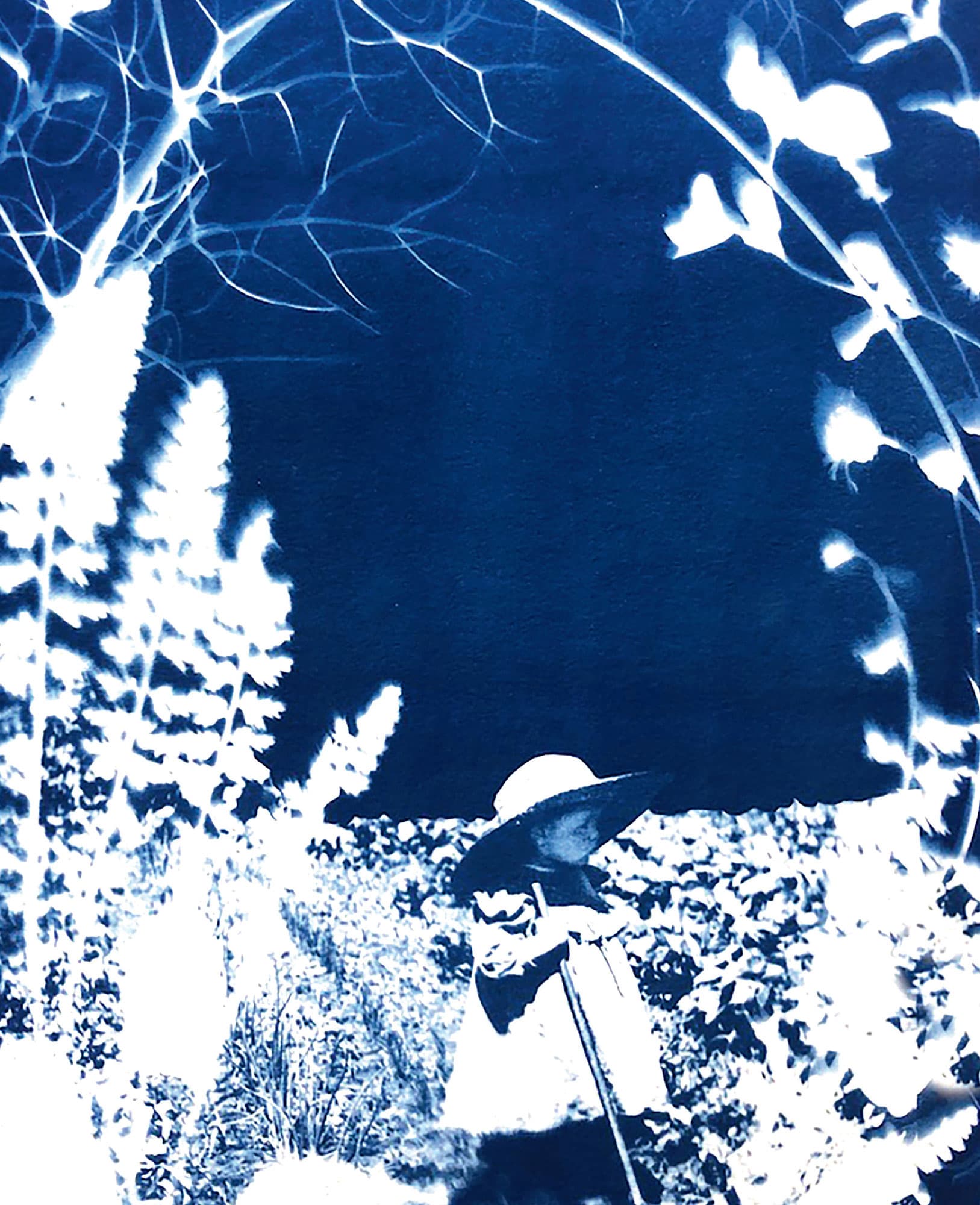
PERMACULTURE AND REGENERATIVE FARMING PRACTICES

Ideally, observe the land you steward for at least a year, noticing how water flows and where it pools in the rainy seasons, and how the sun moves. What parts of your garden have sunlight in the Winter months, when the trees drop leaves but the sun is low? Where does the sun hit in the Summer? Where is that perfect place of balance with ample light and moist, rich soil? Consider your climate. If you live in the northern United States, for example, it is ideal to plant your Summer garden where it will be fully revealed to the sun, because the growing season is short and frequent summer rainstorms will keep the garden moist. In areas such as Southern California, where the summers are hot and dry, however, your garden may thrive with some protection from nearby trees or shrubs. In these Mediterranean climates, deciduous trees will drop their leaves in the winter when your garden needs all the sun it can get. These trees will also create moisture and shade in the oppressive Summer heat so your vegetables don’t burn.
Consider how you move through the land you tend, planning your food garden closest to your kitchen and home. In permaculture, we plan zones based on areas we frequently use and the space they require. While a kitchen garden does not need to be large to produce a lot of food, an orchard, for example, requires more space. It also requires fewer daily visits, so it can be planted further away from the home.
Find the places that are ready to become gardens for food, perennial herbs, or flowers and notice where the soil is struggling. In those places, focus on building soil. This is an important prerequisite for a thriving garden. Each time you grow plants, you should also grow soil. Planting cover crops is a terrific way to heal the Earth and build topsoil.
Regenerative farmers heal depleted land by changing the way it is being farmed. You can do this on a smaller scale. If you are starting with rock-hard, compacted soil, learn the no-till method of regenerative farming. Rather than tilling land, which releases carbon into the air and kills the life of soil, plant daikon radishes the first year. Their roots penetrate hard soil, and when they decompose, they add nitrogen, nutrients, and biology. Plant a mixture of cover crops—nitrogen-fixing plants such as sweet peas and vetch. When they are green and just starting to flower, “chop and drop”: cut them, water them, cover them with hay or alfalfa, and create a layer of composting mulch on the soil. Within one season of planting cover crops in poor soil, you may be able to effortlessly glide your hand into rich, lively black soil that will make your garden thrive, where seeds will easily take, and that will grow nutrient-rich food. After all, vegetables and fruit are only as nutritious as the soil in which they grow! Furthermore, building soil and employing regenerative farming practices feeds your small water cycle, replenishing groundwater, sequestering carbon from the atmosphere, and helping to reverse the climate change crisis. It is empowering and uplifting to realize how much positive change we can create for our planet in our very own backyard! Don’t let it intimidate you—start by planting a cover crop mix. The garden will teach you; the soil speaks too.
POLLINATORS, PERENNIALS, LIFE, AND DEATH

When planting a garden, ensure you are supporting an ecosystem of pollinators. Mixing in native wildflowers and perennial herbs that attract hummingbirds, bees, and butterflies will help you and your garden thrive. Planting a diverse range of plants is beneficial. Visually, you can plant clusters together while ensuring diversity over the whole space. It is best to release the expectation of a manicured garden. Whatever you do, do not take leaf litter and plant material off your property—rather, scatter it at the base of the plants to build mulch. If you can’t bear the sight of it, use a mulch you find visually appealing or plant a groundcover so the soil is never exposed and compost the leaf litter onsite. Consider adding a bird bath to enjoy the presence of birds. Invite life in! Diversity encourages a thriving environment. Invite death in! A garden rich in decay and compost is the garden where life effortlessly grows.
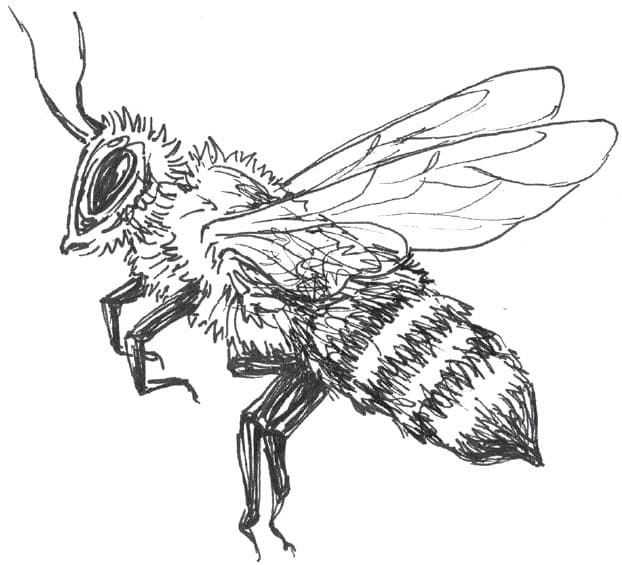
GUERRILLA GARDENING

If you live in an urban environment or frequent areas that have empty lots, sidewalk strips, or any other parcels of land that are not being loved, consider secretly adopting a patch of public space. Find out what native seeds grow best in your area and scatter them at night with prayers to rewild our cities! Get together with your friends and make seed bombs—little balls of seeds, compost, clay, and sand—that you can throw into empty spaces to disintegrate with the rain, releasing seeds and compost. I have been known to drive by urban lots and throw seed bombs out of my car window. How much fun can you have being radical in your love of a healthy ecosystem? How generous can you be in planting seeds for people and places other than yourself? The pollinators that are looking for food in urban places will find the little plant sanctuaries you create for them. A wildflower will tickle the heart of a child. Beauty and play can heal us too.
SPRING RITUALS

As humans, we rely on the rebirth of nature. The rituals that weave us into the awakening of life and land are some of the most ancient practices of our ancestors that we continue today. Easter and Passover, for example, draw on ancient pagan rituals that celebrate and attune us to the rebirth of Spring. Easter celebrates the resurrection of the “sun God,” Christ. It weaves in the delight of children finding eggs in a garden, young lamb roasted on the fire, and rituals of cleansing and blessing water. The symbols predate the Christian holiday. The rabbit is an ancient symbol of the Goddess; the egg is a symbol of the universe. Druids are said to have painted eggs red like menstrual blood and buried them in freshly plowed fields to feed the fertility of the Earth.
The rituals of Passover take us from the emotional misery of death and darkness associated with the archetype of the long winter dark night, to the joyful, long-awaited rebirth of a people with a new life on new land. The various sacred food rituals associated with the Passover meal include bitter spring greens and invite in the participation of children—weaving in the energies of youth, vitality, and innocence.
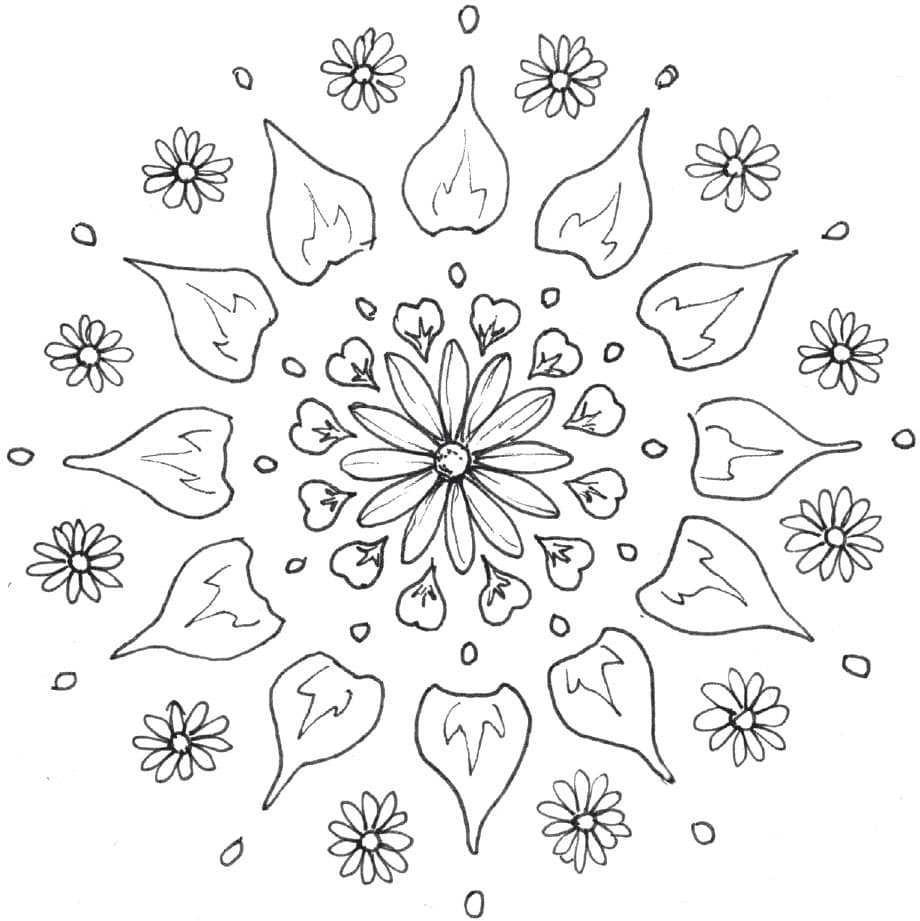
Following are some of my most important Spring rituals. Many of them are very simple and have profound effects in shifting and renewing our energy.
Flower Mandalas and Courting the Earth
As we move on the Great Wheel through the energies of Spring and the maturing Maiden, we enter portals of fertility, ecstasy, and courting the beloved. Rituals of devotion and offerings to the Earth are a wonderful way to weave the energies of Spring into the Great Romance that is taking place all around you. How can you be the most devoted lover to the Earth? What does it mean to be in loving relationship with Nature? How do you court the Beloved? What does it feel like to sing songs to the dawn, leave flowers for the fairies, and create random acts of beauty and kindness?
Creating a flower mandala in the spring is such a practice. As the poet Rumi said, “Let the beauty we love be what we do. There are hundreds of ways to kneel and kiss the ground.”
Allow the ritual to be in the gathering of the flowers. Walk through your garden with a prayer, asking which flowers wish to become an offering of beauty. Harvest them with gratitude and collect them into your basket. Alternatively, create a flower mandala in your community, inviting everyone to bring flowers. Set the intention for the mandala and invite this ritual to occur without verbal communication, but rather with the intention of working together like a hive of bees, in harmony and alchemy. Invite your friends to leave the flowers on the Earth and begin intuitively arranging them. Before beginning, when setting the intention of working like a hive, I share that it is okay to move other people’s flowers without attachment to our part of the creation—that the whole is greater than the sum of its parts. And so we create beauty and finally step back to take it in. End by holding hands, sometimes speaking prayers or a dedication of the offering to the Earth.
Earth My Body: Harmonizing Your Body with the Earth Mother’s Body
The Earth’s magnetic field vibrates at 7.83 Hertz, which is called the Schumann Resonance. Scientists are now finding evidence that “earthing,” or connecting our bare feet or bodies to the surface of the Earth for twenty minutes a day, has a profound healing and anti-inflammatory effect on the body. Astronauts who travel into space have a machine that creates this electromagnetic vibration. We are like plants—unrooted and disconnected from the Earth, we become isolated, get ill, and die.
You can harmonize your body with the Earth daily for optimal health and well-being. Although it weaves us into the Earth energy of the North portal, it is often when Gaia begins awakening in the Spring that this practice becomes available. It feels deeply grounding and calming, but it is surprisingly energizing as well. Upon coming into harmony, you should feel at peace in your mind, relaxed in your body, uplifted in your heart, and renewed in spirit.
1. Walk into Nature—your garden, a park, or anywhere you can access the body of the Earth.
2. Lie down. I recommend you start on your back. Close your eyes, lay your palms on the Earth or your belly and heart, and begin to breathe deeply, releasing tension each time you exhale.
3. Spend a few minutes feeling your mind settle and your body relax. Feel the support of the Earth holding you. Often five minutes is all it takes to feel a profound difference in your energy and a grounding.
4. Then flip over. You will find a whole new layer is available when you lay your body the other way against the belly of the Mother. Again, close your eyes, breathe, relax, let go, and receive from the Earth.
This is my favorite practice to do before any ceremony, teaching, or ritual. It is the quickest and most profound way to come into harmony with the Earth’s healing vibration, and all it takes is ten to twenty minutes. Of course, you can do this for hours, which feels utterly divine. The longer you lay your body on the Earth, the more portals open.
Egg Cleansing
This ritual, a form of limpia ceremony, was shared with me by a shamanic teacher as well as women in Mexico. It is a folk practice found in many cultures, though I have predominantly found it woven into Latin American folk remedies. I humbly pass it on with permission, though I am of Polish descent. Many of my Latina Gaia Witches have laughed when I share it, saying that their mothers and aunties do this—and if one of them has a headache or is stressed, they will call out, “Get the huevo!” My heart has had the blessing of witnessing my sisters of Latina heritage weep in the reclamation of this beautiful ceremony—it is so simple, yet so profound and healing. What we sometimes reject as Maidens returns to us on the spiral dance, and it may become a practice that weaves us with our ancestors.
This ceremony cleanses the energetic body of negative and dense energies. It is also used to relieve energy that causes stress and tension headaches. It is very calming and purifying to the heart. You can do it in the home, though I prefer to do it outside and to do it for someone and receive from someone, rather than doing it for myself.
My young daughter and I will often do this together, laying a blanket in the garden and offering each other an egg cleansing or full-body massage with the egg. Flora likes it when I have one egg in each hand and work on her body with both as she lies on the Earth with her eyes closed. The result is always a purified spirit and gentle, open heart full of wonder and awe.
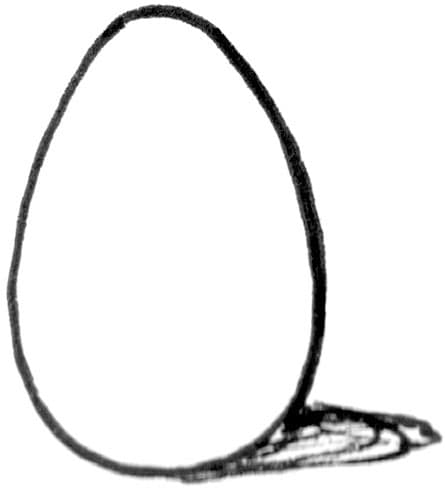
You will need:
An egg, preferably one from a chicken that has had a happy, natural life
1. Holding the egg in your hand, close your eyes. Connect to your prayer or intention.
2. Rub the egg all over your or the other person’s body. Start with the head, massage the face and neck, and move all the way down to the toes.
3. Notice how the egg pulls dense energy from the body, making you or the person you’re working on feel lighter.
4. Return the egg to the Earth, giving gratitude.
Sacred Seed Planting
Any time you plant seeds, you have the opportunity to weave your intentions, prayers, and even biological needs into the miracle of the seed and its potential.
You will need:
Seeds
1. Observe the seeds you hold with the eyes of a child. Be in wonder and awe! Each seed is different in size, texture, shape, and color—study them as a world.
2. Open your heart to the feeling of eternity held in the moment of this seed and of your seed spell. This seed comes from ancient lineages, has stories of diverse lands, and holds the prayers and preferences of people who cultivated it, protected it, and spread it over generations, allowing it to arrive to you. It also has the potential of living into eternal futures; just this one seed will become a plant with potentially thousands of seeds, each one of those able to make thousands more.
3. Now allow your prayers and intentions to feel the vastness they are entering! Picture the potential, the avenues of time and timelessness.
4. Pray into the seeds. My preferred method is lying on the Earth (after harmonizing my body with it—see here) and laying the seeds on my womb or belly. If they are small, I often cup them in my hands and hold my hands to my heart. You may whisper or speak directly into the seeds.
5. A different method of transferring your energy into the seeds is to place them under your tongue for a minute. Envision your intentions or simply lie on the Earth and allow the darkness of your body and the information of your biology to transfer energetically through your saliva. Then place the seeds onto the palm of your hand and hold them to the sun, speaking your prayers, casting a spell with balanced lunar and solar energies.
6. Plant your seeds into the dark flesh of the Earth Mother.
SPRING PORTAL HERBS
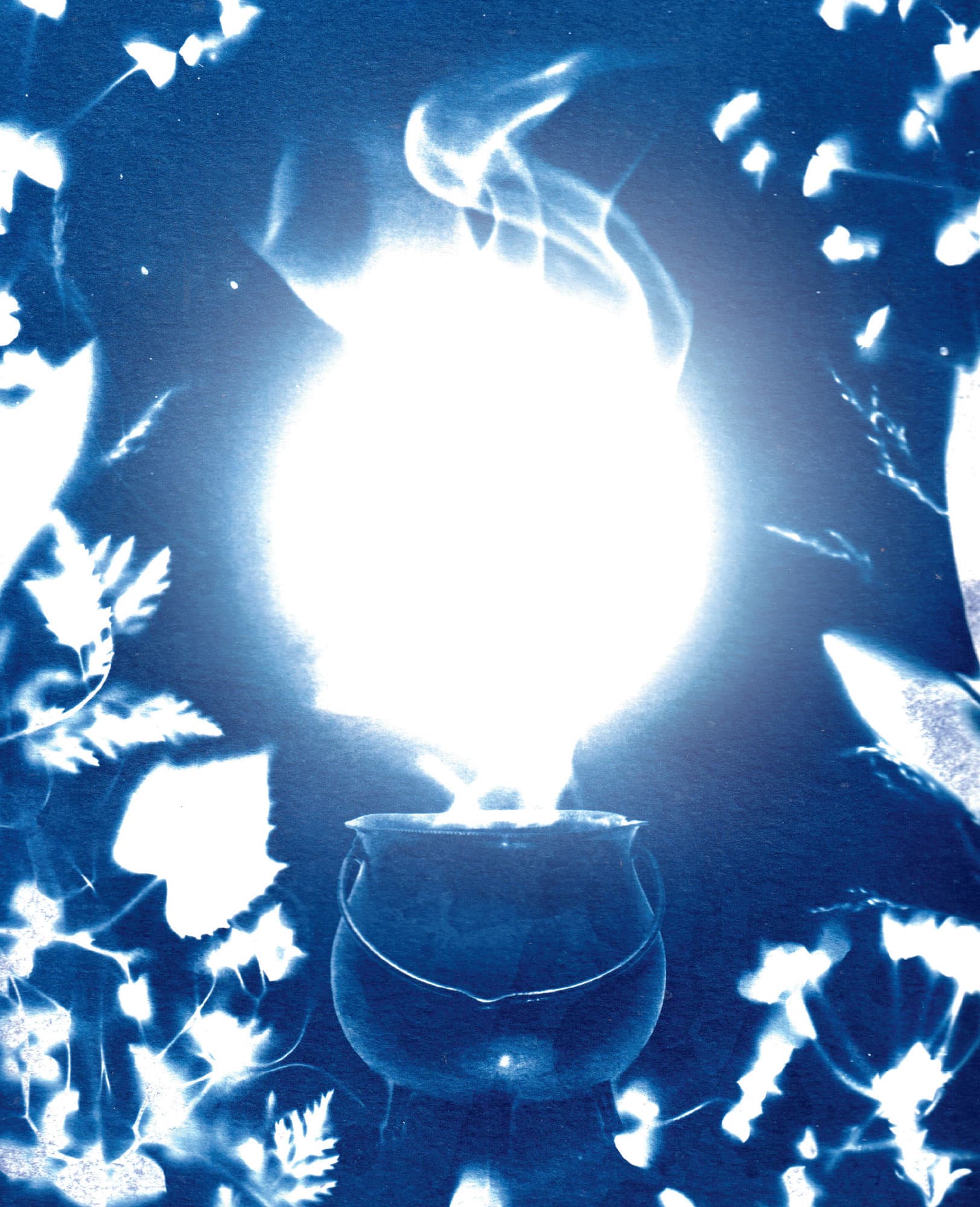
plant profile
Oat Straw
LATIN NAME Avena sativa
FAMILY Gramineae (grass family)
An annual grass native to northern Europe, now covering meadows and hills worldwide, oat straw grows peacefully and happily in poor, dry soil. Her green fields dance in the spring wind, are cultivated for oatmeal, and turn golden in the late-Summer sun. Each plant grows up to 4 feet (1.2 m) tall, with a hollow jointed stem. The pale green leaves are narrow and flat, and the green flowers are born in loose terminal clusters, with each spikelet consisting of two florets. You can pop the oat tops to release a drop of white “milk” before they turn to grain. The flowers are hermaphroditic and are pollinated by the wind.
HERBAL AND MEDICINAL PROPERTIES
• Nutritive tonic and nourishing herb, both food and medicine: rich in protein, fats, minerals, vitamin B, and fixed oils (source of vitamin E)
• Cardiac tonic: strengthening to the heart and a wonderful ally for lowering cholesterol
• Nervine: calming, relaxing, and restorative to the nervous system; it brings a state of peace and calm while also energizing the body when used consistently
• External emollient: soothing and moistening to inflamed skin; calms eczema, rashes, etc.
• Strengthening ally for times of stress, lifting us out of depression
• Increases stamina and sexual vigor; balances hormones
PLANT SPIRIT HEALING
Oat straw’s gently nourishing spirit feels like a sunny breeze and a moist meadow. In times of stress and nervous-system overwhelm, call on the spirit of oat straw to transport you to the peace and bliss of a field with dancing green grasses and grazing horses. There, she will soothe your nerves as you rest and lie on her fertile soil, flooding your body with all the nutrients it needs so it can relax and trust that it is taken care of. Your heart will grow in strength and confidence, and after you have rested and restored, you may feel a surge of energy and joy that calls you to run through the fields like a child. Oat straw brings youth and vitality back to those who have become bitter or closed. She builds trust and balance in the heart, mind, and solar plexus, increasing self-love, confidence, and feelings of inner peace and harmony. Vital, nourished, and connected, we find a renewal of stamina and enthusiasm for life.
FAVORITE USES
• Hot overnight infusion (drink daily for a month or more)
• With other nourishing herbs in tea blends
• Oat-mylk tincture, a favorite nervine
• Fresh milky oat juice (Mother’s Earth Breast Milk, shown here)
• Oat seeds with chamomile flowers in the bath for children, to calm and soothe
• Face masks of hydrated oats, rubbed as gentle exfoliant
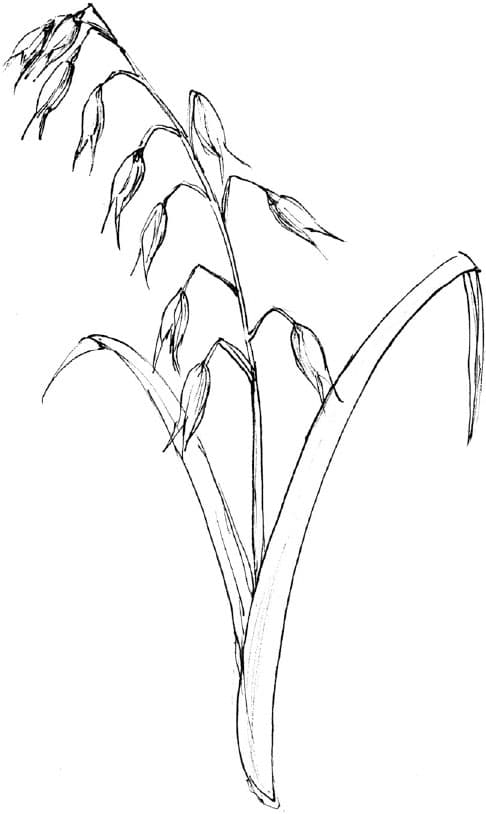
plant profile
Burdock
LATIN NAME Arctium lappa
FAMILY Asteraceae/Compositae (aster family)
Native to Europe and Asia, burdock is a common weed growing in temperate regions throughout the world. Often found in meadows, in woods, and at the side of the road, burdock favors disturbed Earth and draws deep nourishment from his long taproot, healing the earth. The root is prized as a detoxifying herb in both Western and Chinese medicine and may be dug up in the fall of the first year of growth. Burdock is a biennial plant with a tall stalk and huge, wavy leaves that grows 6 to 10 feet (1.8 to 3 m) in height and 3 feet (0.9 m) in width. You can recognize it by its pinkish-purple flowers and the brown burrs that stick like Velcro. The taproot is up to 3 feet (0.9 m) long.
HERBAL AND MEDICINAL PROPERTIES
• Nutritive, nourishing herb for restorative food medicine
• Rich in inulins: aids in absorption of nutrients, digestion
• Detoxifying: cleansing to the blood, decongesting to the liver
• Alterative: improves the functioning of the organs of elimination
• Lymphatic: cleansing to the lymphatic system
• Clears skin eruptions, psoriasis, eczema, acne, and irritations associated with body trying to detoxify and being overtaxed
• Diuretic
• Has antimicrobial, antiviral properties
• Anticarcinogenic: supportive for treating cancer
• Nourishes the reproductive system, nervous system, immune system, and digestive system, grounding the body while gently and deeply cleansing old energies, emotions, and toxins
PLANT SPIRIT HEALING
Burdock is a deeply grounding, strengthening, nourishing, and supportive plant spirit that can gently yet effectively go to the root of the wound, moving old, stagnant energy out. The Earthy root is healing and supportive to the root chakra and moves the water element in the body, purifying the emotional realms and nourishing the creative center of the sacral chakra. Consistent use of burdock creates gentle yet deep transformation in the solar plexus and digestive system, strengthening and unclogging the systems and organs of elimination. Often, when we begin working with burdock, our body begins to dig deep and we eliminate more from our bowels, our metabolism comes into greater balance, and we feel emotionally and spiritually lighter as well. Burdock’s plant spirit often offers incredible support through a period of healing— allowing our souls to feel held, nourished, and deeply loved. The energy often feels like a safe masculine energy, and I have witnessed a great number of healings occur in which the inner masculine and inner feminine aspect have come into greater harmony within a person, where anger to the masculine washed away and an embodied experience of what a safe masculine energy feels like nourishes and offers healing to an aspect of the body, heart, and soul.
FAVORITE USES
• Overnight hot infusion of dried or fresh herb (drink for a month or more)
• Food medicine: Add to rice, soup stock, bone broth, vegetable purée
OTHER USES
• Leaves can be used for poultices
• Love spells
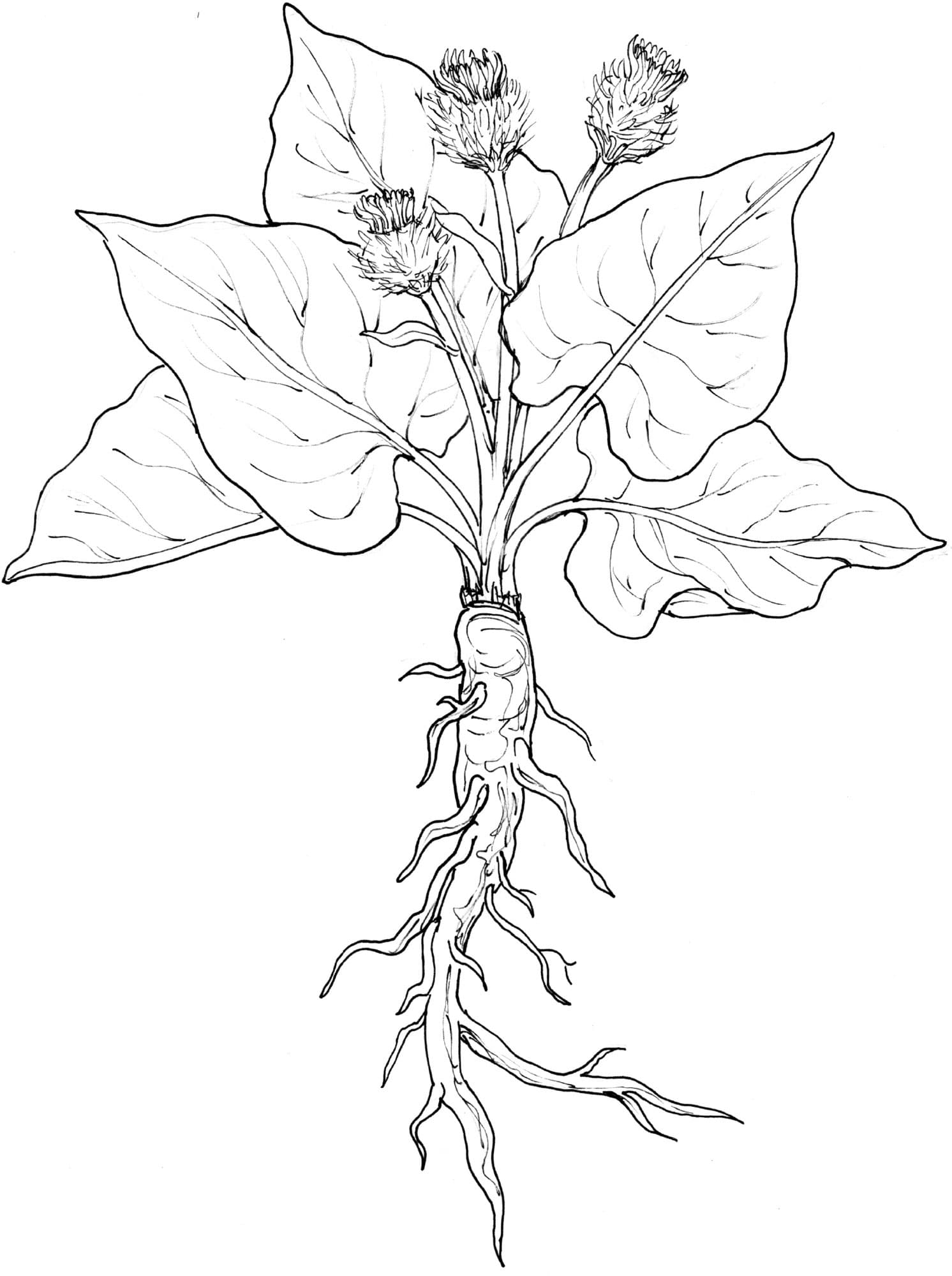
plant profile
Stinging Nettles
LATIN NAME: Urtica dioica
FAMILY: Urticaceae (nettle family)
This perennial medicinal weed grows wild worldwide and has been used since ancient times for food, fiber, medicine, and magick. Nettles favor forests, woodlands, and moist soils. They often spread in a large cluster, each plant growing up to 3 to 6 feet (0.9 to 1.8 m) with a width of 2 to 3 feet (0.6 to 0.9 m). Their serrated leaves come to a point and are covered with stinging hairs, as is the stem. In the Spring, the nettle’s tender green leaves are a food and a nutritive, cleansing tonic. In the Summer months, small, delicate white flowers cluster and dangle like earrings. Her medicinal seeds can be eaten and pressed for oil, her root harvested in the Fall.
HERBAL & MEDICINAL PROPERTIES
• Nutritive, nourishing herb: full of vitamins, minerals, enzymes.
• Tonic: building new tissue, revitalizing, healing, replenishing
• Beauty herb: building to hair, nails, and skin
• Foundational medicine: where we begin and a safe go-to for all ages after surgery, injury, or illness for healing, replenishing, and nourishing the body
• Digestive system tonic: aids in absorption of nutrients
• Cleansing: supports organs of elimination
• Kidney tonic: diuretic, cleansing to the urinary tract
• Nerve tonic: healing to the adrenals, grounding, calming, energizing.
• Circulatory system tonic: supports the cardiovascular system
• Anti-inflammatory, anti-allergen, strengthening to the immune system
• Antirheumatic, used topically to beat inflamed joints.
• Antiprostatic: used for enlarged prostates
• Menstrual/pregnancy herb: regulating to menses and hormones, building blood, nutritive for pregnancy, postpartum, menopause, lactation
PLANT SPIRIT HEALING
Nettle is a gateway herb for the Green Witch, weaving us back into the fabric of all inside of us and in the Earth that is wild, vital, and free. The first drink of a strong, cold overnight infusion satiates a primordial thirst for deep nourishment that often the cells and soul did not even know they had until then. This grounds the spirit, releasing tension from the physical and emotional body, allowing fear and tightness in the root chakra to dissolve. Thus, we become more grounded, able to bring in nourishment and Earth energy into the body. With daily use, we notice how different we are when we are flooded with nourishment, our basic needs met, our heart open, the taste for wildness and aliveness igniting our spirit, joy and sense of self. The sacral chakra and water element are nourished, the solar plexus, digestive system, and center of courage are awakened, and we begin to exercise better boundaries—finding more clarity and ease in communicating our yes and our no. Nettle is unapologetic, feisty, deeply loving, and wild. It can give us a good talking-to if we are not advocating for ourselves or the Earth, or if we are unbalanced, giving our energy away and becoming depleted. It’s a powerful ally for caretakers, healers, mothers, creators, and those who seek to strengthen their communication and mind. Once an ally, nettles becomes foundational, an ally forever.
FAVORITE USES
• Overnight infusion of dried or fresh herb in cold water (drink for a month or more)
• Food medicine: Cook with nettles as with spinach—try nettle quiche, soup, or pesto
• Add leftover nettles from tea to the garden and compost
• Make a second hot infusion with leftover plant material for a hair rinse
OTHER USES
• Fiber for cloth and paper
• Spells of protection
• Natural dye
• Activator for compost, regenerating the Earth; nettle tea for soil
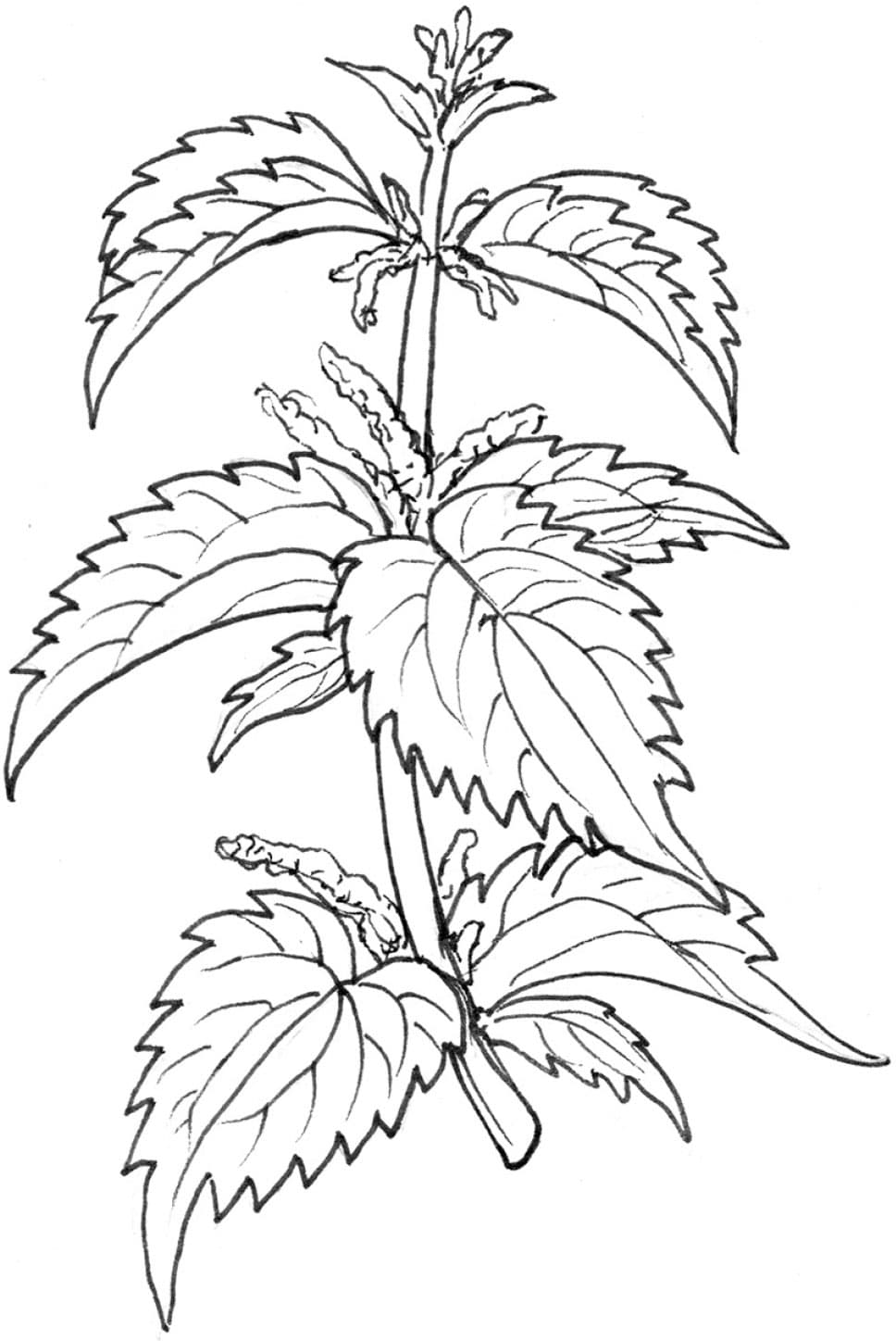
plant profile
Yerba Santa
LATIN NAME Eriodictyon californicum
FAMILY Boraginaceae, subfamily Hydrophyllaceae (waterleaf subfamily)
This perennial sticky, shiny, dark-green shrub is native to California, Oregon, and Northern Mexico and lives on dry, sunny mountain slopes. It grows to about the height of a human; its long, serrated, tapered leaves are resinous, leathery, and dark; and it has a surprisingly beautiful panicle of small, purple flowers appearing in late Spring. You can find this ally of the sun and air in wild places where the dust of the desert coats its leaves. After a wildfire went through the land near me, yerba santa was one of the first plants to come back, rejuvenated, rebirthed, bright, vigorous, larger, and healthier then I had ever seen. A couple years later, these patches thrive, renewed.
HERBAL AND MEDICINAL PROPERTIES
• Expectorant: incredible ally for lung and respiratory infections; promotes coughing up of mucous and release of deep, stagnant dark energy
• Bronchodilator and decongestant: opens up breath and air passageways; ally for seasonal allergies and asthma
• Highly aromatic: the bitterness and pungency of yerba santa act as a carminative, helping with digestion
• Antimicrobial: the essential oils kill microbes and have a cleansing and purifying effect on the mucous membranes and body
• Used for thousands of years by the Native people of its lands; the name yerba santa means “holy herb” and suggests it was used for a variety of ailments.
• I enjoy mixing this herb with my smoke blends, feeling how it opens up my breath and lungs with its lovely aroma.
• The plant speaks to me in meditations about using her for oral health; I often find myself rubbing her leaves along my gums when I am hiking, and I can feel how this increases circulation around my teeth and is cleansing
PLANT SPIRIT HEALING
Yerba santa grounds the spirit, calming the nervous system, quieting the mind, and opening the breath. This quality makes the plant spirit a wonderful ally for meditation and shamanic journeying. It also goes deep into dark places, illuminating shadows while holding the nervous system in peace and loving support. Darkness dissolves, and I am often shown what is being healed or how to remedy a situation. The resinous, purifying oils coat my throat and insides as I drink him in, opening my breath, lungs, and heart. This plant spirit brings the gift of purification, peace, and quiet while shifting consciousness, helping us access deeper states of consciousness and meditation and opening the third eye and crown chakra from a grounded, still, rooted place.
FAVORITE USES
• Hot tea for colds, lung infections, and meditation
• With mullein in an herbal smoke blend
• As a honey or alcohol/honey elixir
• As an ingredient in cough syrup
• To rub on the teeth and gums for oral hygiene in the wilderness
• To sit with in the wild, appreciating its grounding, calming, and beautiful presence

EAST PORTAL JOURNAL PROMPTS

Reflect on the element of air in you.
Air element in balance
• Great imagination, visioning, and intelligence balanced with the grounded ability to bring dreams into manifested form (balanced with earth)
• Open-mind balanced with knowing yourself and good boundaries (balanced with fire)
• Ability to think and feel in a balanced way (balanced with water)
Air element out of balance
• Being scattered, flighty, inconsistent, uncommitted, or forgetful (needs more earth)
• Anxiety, nervousness, or paranoia (needs more earth and balanced fire)
• Excessive multitasking, being involved in too many projects, inability to focus on one thing (needs more earth)
• Unable to feel emotions and be with the feelings in the body, wanting to explain things away (needs more water)
Close your eyes and call in your inner child or Maiden archetype.
Reflect on how you can nourish your inner Maiden archetype in your journal:
• How can you cultivate more spontaneous play? Make a list of play dates you want to have with yourself or others. Put them in your calendar. Make them happen!
• How can you put yourself in the right time and place for an adventure?
• What would be fun?
• What does your inner child love?
• Create a vision board for your year, your dream career, home, life, or the like. What other playful, creative, or practical ways can you vision, dream into, and plan for your future?
• What are some new habits you would like to incorporate into your way of moving through the world? How can you start with baby steps and grow into that full expression?
